Washington is home to a wide variety of birds, ranging from majestic bald eagles to small hummingbirds.
With over 500 species of birds found in the state, Washington is a great place for bird enthusiasts of all kinds.
From the coastal shorelines to the mountains, Washington offers a diverse and beautiful array of bird habitats.
In this article, we will explore some of the most interesting and common birds of Washington.
1. Black-Capped Chickadee

The black-capped chickadee is a small and cheerful songbird found in deciduous and mixed forests across North America. It has an iconic black cap, white cheeks, gray back and wings with whitish bars on them.
The underparts are usually light colored or greyish brown. This species is well adapted to cold winters as it can reduce its body temperature by up to 8°C while roosting at night; this helps save energy during the colder months of the year.
It feeds mainly on insects but also eats seeds, fruits and suet from bird feeders when available.
Black-capped chickadees are popular birds among backyard visitors due to their sociable nature – they often establish lifelong partnerships with one another for breeding purposes.
Furthermore, they have been designated as state birds of Massachusetts and Maine in USA plus New Brunswick in Canada – a testament to how beloved these little avian friends truly are.Scientific classification:
| Kingdom | Animalia |
| Phylum | Chordata |
| Class | Aves |
| Order | Passeriformes |
| Family | Paridae |
| Genus | Poecile |
| Species | P. atricapillus |
2. House Finch

The House Finch is a species of finch native to western North America and has been introduced in the eastern half of the continent as well as Hawaii.
It’s an average-sized finch with adults measuring 12.5 – 15 cm (5 – 6 inches) long and having wingspans between 20 – 25 cm (8 – 10 inches).
The upperparts are brown, while its underparts range from pale grayish white to yellow depending on subspecies.
Its face is streaked or spotted with reddish coloration; males typically have brighter plumage than females due to sexual dimorphism.
They’re mostly found near human habitations such as farms and gardens where they feed on grains, fruits, insects etc., making them very popular among birders who want something colorful for their backyard.Scientific classification:
| Kingdom | Animalia |
| Phylum | Chordata |
| Class | Aves |
| Order | Passeriformes |
| Family | Fringillidae |
| Subfamily | Carduelinae |
| Genus | Haemorhous |
| Species | H. mexicanus |
3. American Goldfinch
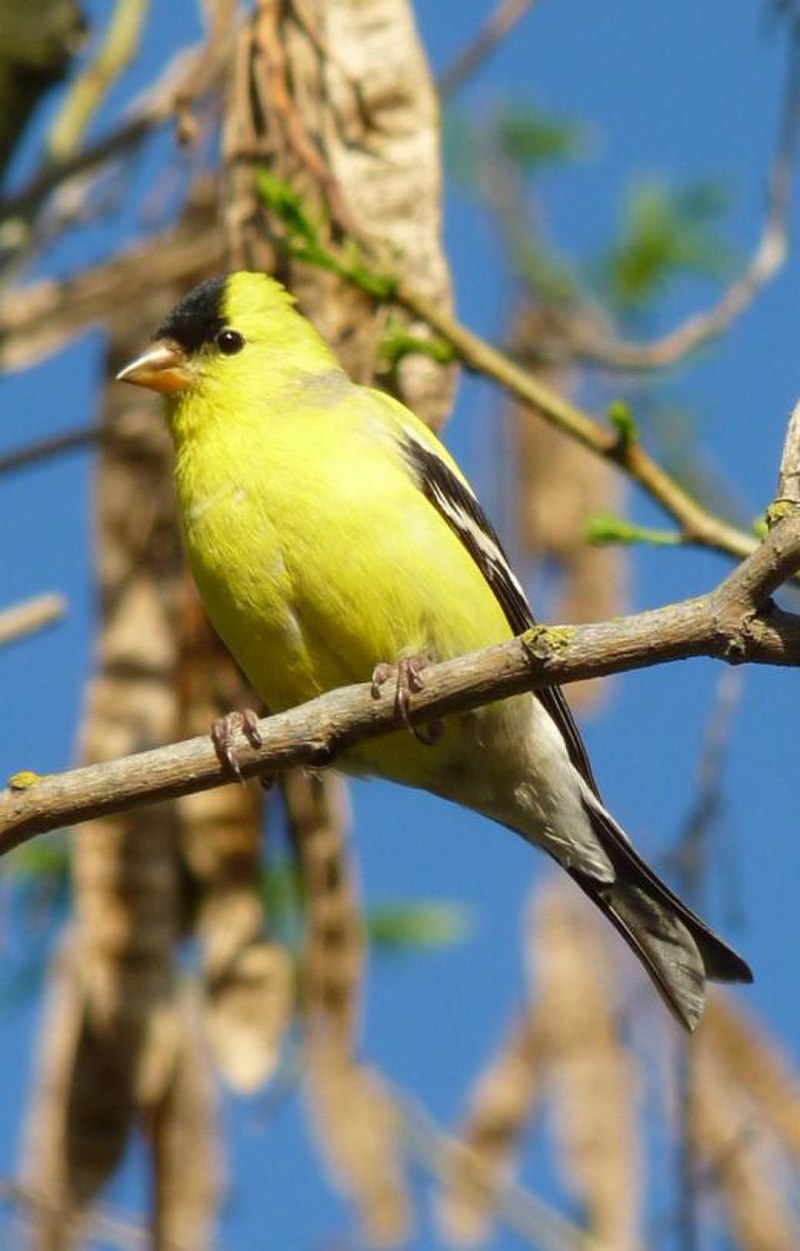
The American goldfinch is a small North American bird in the finch family. Males are vibrant yellow with black wings and tail, while females are duller in colouration.
It migrates from mid-Alberta to North Carolina during breeding season, south of Canada–United States border to Mexico for its wintering grounds.
The only finch which undergoes complete molt every year, it displays sexual dichromatism where males have brighter colours than their female counterparts.
They feed mainly on seeds but also eat insects such as aphids and caterpillars when raising youngs; they often occur near thistles or other plants that produce viable seed heads.
Their call consists of an array of chirps and trills making them quite conspicuous.Scientific classification:
| Kingdom | Animalia |
| Phylum | Chordata |
| Class | Aves |
| Order | Passeriformes |
| Family | Fringillidae |
| Subfamily | Carduelinae |
| Genus | Spinus |
| Species | S. tristis |
4. American Robin

The American robin is a migratory bird, belonging to the true thrush genus and Turdidae family.
It was named after its European counterpart due to the similar reddish-orange breast they both possess; however, they are not related closely.
This species can be seen through most of North America during winter months, as well as in parts of Mexico and Central America where it also breeds.
They have plump bodies with gray upperparts and white underparts that vary from yellow on their throats down to orange toward their bellies.
Robins feed on fruits such as berries or insects like worms which makes them an important part of ecosystems by helping disperse seeds naturally throughout these areas.Scientific classification:
| Kingdom | Animalia |
| Phylum | Chordata |
| Class | Aves |
| Order | Passeriformes |
| Family | Turdidae |
| Genus | Turdus |
| Species | T. migratorius |
5. Anna’s Hummingbird
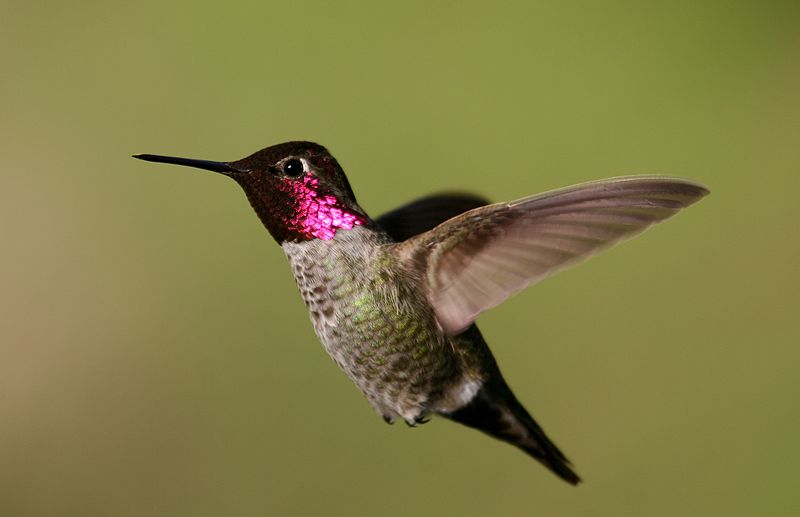
Anna’s hummingbird is a beautiful species of bird belonging to the Trochilidae family. Native to western coastal regions of North America, it was named after Anna Masséna, Duchess of Rivoli.
In the early 20th century, these birds bred only in northern Baja California and southern California but due to ornamental plant transplanting they can now be found across much of Pacific Coast region.
They are medium-sized with bright emerald green feathers on their back and crowns as well as rose-red patches at the throat for males which makes them quite distinguishable from other birds.
Their diet consists mainly nectar from flowers although they will occasionally feed on insects or spiders too making them important pollinators that help maintain healthy ecosystems.Scientific classification:
| Kingdom | Animalia |
| Phylum | Chordata |
| Class | Aves |
| Order | Apodiformes |
| Family | Trochilidae |
| Genus | Calypte |
| Species | C. anna |
6. Dark-Eyed Junco

The Dark-eyed Junco is a species of small, grayish sparrows that are found across much of temperate North America and in the Arctic during summer.
It was formally described by Carl Linnaeus in 1766, who named it after its distinctive dark eyes.
This bird has a very variable appearance due to the many different subspecies it contains, making its systematics difficult to unravel.
The plumage varies from white or light gray on their underparts with slate grey backs and wings; black heads with white outer tail feathers; brown head stripes; yellow bills; pink legs and feet; as well as various shades between all these colours.
They also have considerable sexual dimorphism where males tend to be more colourful than females but share similar characteristics such as short tails and rounded bodies – both sexes being around 16 cm long when fully grown.Scientific classification:
| Kingdom | Animalia |
| Phylum | Chordata |
| Class | Aves |
| Order | Passeriformes |
| Family | Passerellidae |
| Genus | Junco |
| Species | J. hyemalis |
7. Common Starling

The Common Starling is a medium-sized passerine bird that belongs to the starling family. It has glossy black plumage with a metallic sheen, and in certain times of year it can be speckled with white.
The bill and legs are typically pink or black depending on the season, while its length measures about 8 inches long.
Its diet consists mainly of insects but also includes small fruits and seeds as well as some human food waste.
They live in large flocks which provides protection against predators, although they can become quite aggressive when defending their nesting sites during breeding seasons.
Overall, this species is highly adaptable and widely distributed across many parts of Europe making them one of the most successful birds in the region today.Scientific classification:
| Kingdom | Animalia |
| Phylum | Chordata |
| Class | Aves |
| Order | Passeriformes |
| Family | Sturnidae |
| Genus | Sturnus |
| Species | S. vulgaris |
8. Steller’s Jay
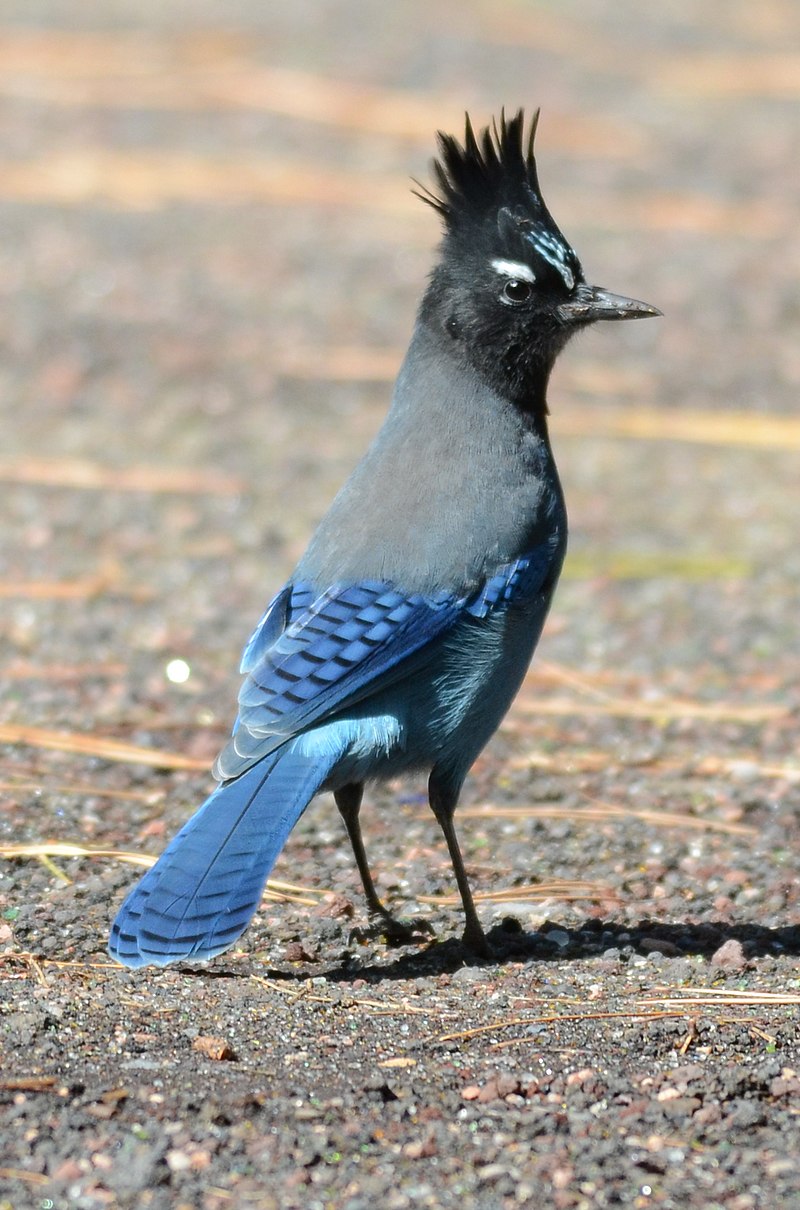
Steller’s jay is a beautiful and colorful bird native to western North America and the mountains of Central America.
It has a distinctive long crest that sets it apart from other birds, with its blue feathers streaked with black, white, gray, and brown markings.
This species is closely related to the blue jays found in eastern North America but can be distinguished by their longer crests.
They are known for being highly vocal birds who like to make loud calls throughout forests they inhabit as well as stealing food from unsuspecting mammals or raiding bird feeders when given the chance.
Steller’s Jays have adapted well to human presence in areas they populate making them great backyard visitors if you’re lucky enough.Scientific classification:
| Kingdom | Animalia |
| Phylum | Chordata |
| Class | Aves |
| Order | Passeriformes |
| Family | Corvidae |
| Genus | Cyanocitta |
| Species | C. stelleri |
9. Chestnut-Backed Chickadee
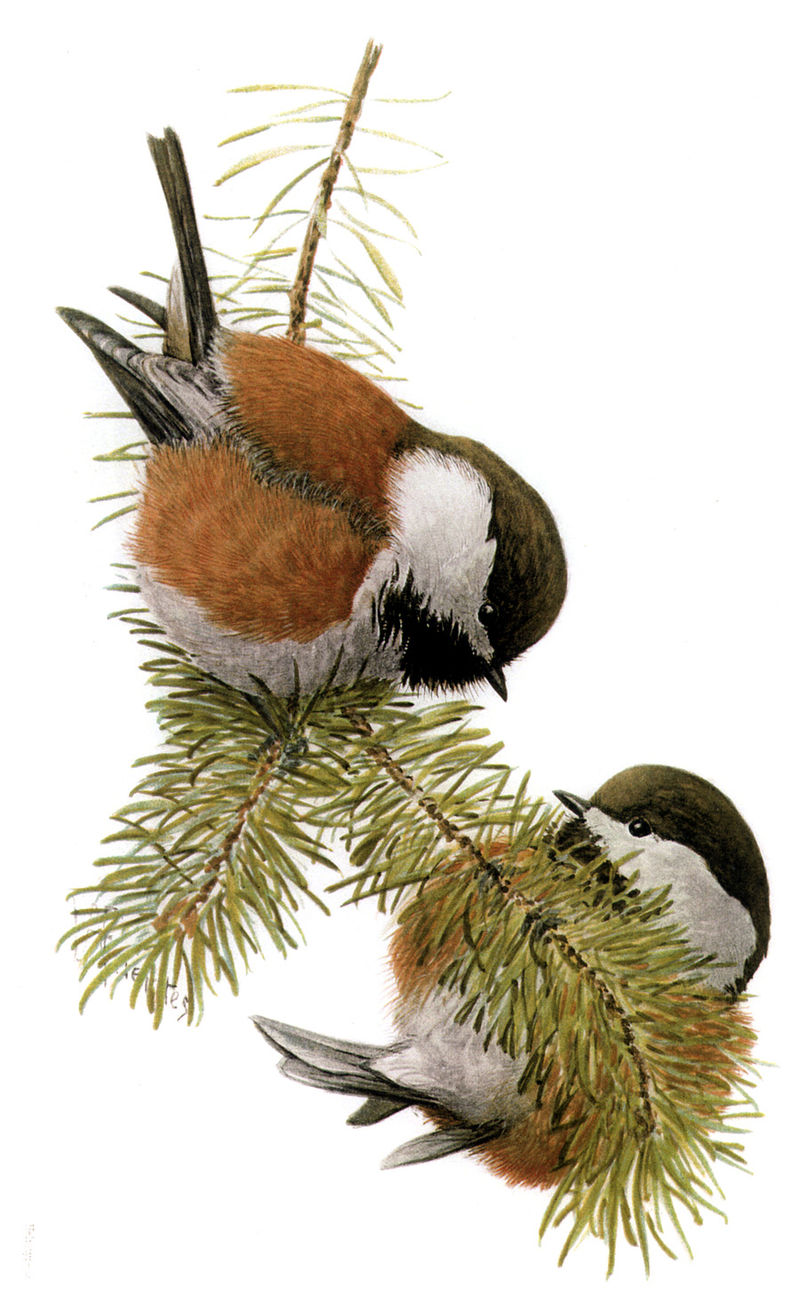
The Chestnut-backed Chickadee is a small passerine bird in the tit family, Paridae. It lives within the Pacific Northwest region of America and Canada; its range extending from southern Alaska to southwestern California.
This species remains a permanent resident throughout its area rather than migrating seasonally, although feeding flocks may temporarily move short distances for food sources.
They are commonly found in woodlands with dense understory vegetation as well as suburban gardens.
The male and female birds can be distinguished by their distinctive patterned plumage: males have brown backs while females are grayer above but both share white bellies and buffy sides striped with black barring across their wings and tails.
These sociable birds usually feed on insects or seeds which they obtain from trees or shrubs using their sharp beaks.Scientific classification:
| Kingdom | Animalia |
| Phylum | Chordata |
| Class | Aves |
| Order | Passeriformes |
| Family | Paridae |
| Genus | Poecile |
| Species | P. rufescens |
10. Red-Breasted Nuthatch

The Red-breasted Nuthatch is a beautiful and vocal songbird that can be found in coniferous forests across Canada, Alaska, the northeastern United States and western US.
This small bird has blue-grey upperparts with cinnamon underparts, a white throat and face with black eye stripe, straight grey bill and black crown.
Its call sounds like a tin trumpet; it’s high-pitched yet nasal.
During mating season they form monogamous pairs to build their nest near tree trunks or branches at low heights off the ground where they lay 2 – 8 eggs at once.
They are very active little birds who love clinging to trees while searching for insect larvae or seeds within the bark of trees which helps control pest populations.Scientific classification:
| Kingdom | Animalia |
| Phylum | Chordata |
| Class | Aves |
| Order | Passeriformes |
| Family | Sittidae |
| Genus | Sitta |
| Species | S. canadensis |
11. Barn Swallow
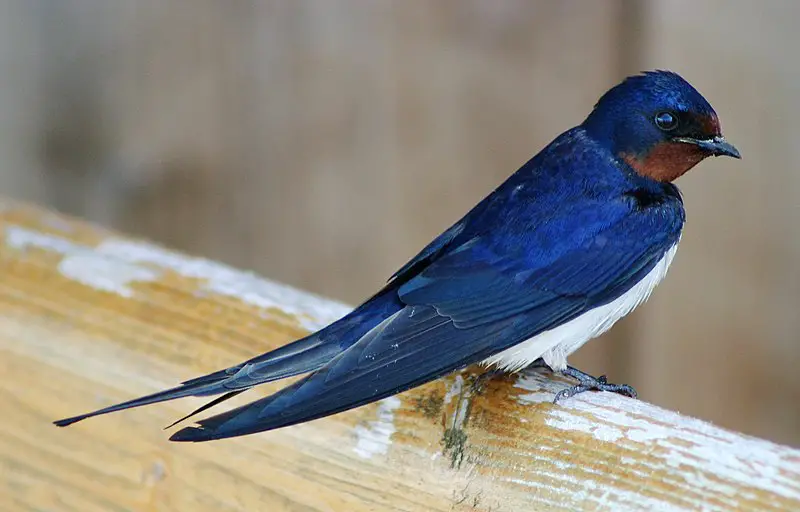
The Barn Swallow is a beautiful passerine bird with blue upperparts and a long, deeply forked tail. Found in Europe, Asia, Africa and the Americas.
It has an astonishingly large natural distribution spanning 251 million square kilometres globally; likely making it one of the world’s most widespread species.
This swallow typically nests near human habitation as well as other open areas such as fields or grasslands which provide them with suitable invertebrate prey to feed on.
They are insectivorous birds that often fly together in flocks looking for food over rivers or marshes usually just above tree-top level.
The barn swallow can also be identified by its strong flight consisting of swift continuous wing beats interspersed with glides during which they hold their wings slightly raised at the shoulders giving them distinct V shaped silhouettes in the sky.Scientific classification:
| Kingdom | Animalia |
| Phylum | Chordata |
| Class | Aves |
| Order | Passeriformes |
| Family | Hirundinidae |
| Genus | Hirundo |
| Species | H. rustica |
12. American Crow

The American crow is a large bird of the Corvidae family, native to most parts of North America.
It is similar in size and structure to its European counterpart, the carrion crow, as well as Eurasia’s hooded crow.
The three species occupy the same ecological niche, but are distinguishable by their differences in appearance.
American crows have black feathers covering their entire body with wingspan averaging between 17-21 inches wide for males and 16-19 inches for females.
They feed on insects such as grasshoppers, beetles and caterpillars; they also eat grains from fields or abandoned farms during winter months when food sources become scarcer.
In addition to feeding habits American crows can be identified by their distinct call which resembles a “caw” sound that travels long distances over open terrain making them popular among birdwatchers.Scientific classification:
| Kingdom | Animalia |
| Phylum | Chordata |
| Class | Aves |
| Order | Passeriformes |
| Family | Corvidae |
| Genus | Corvus |
| Species | C. brachyrhynchos |
13. Song Sparrow

The Song Sparrow (Melospiza melodia) is a small, yet abundant bird found in North America.
They have brown upperparts with dark streaks and are white underneath, complete with a distinct dark brown spot on the breast.
Their cap is also brown and long roughed feathers can be seen sprouting from their neck area.
This sparrow species is highly variable and adaptable to many different environments including dry brush land, wetlands or open fields.
It has been noted that adult song sparrows will sing even during winter months when other birds remain quiet.
These energetic little animals make for great backyard companions as they flit about singing their lovely melodies.Scientific classification:
| Kingdom | Animalia |
| Phylum | Chordata |
| Class | Aves |
| Order | Passeriformes |
| Family | Passerellidae |
| Genus | Melospiza |
| Species | M. melodia |
14. Pine Siskin
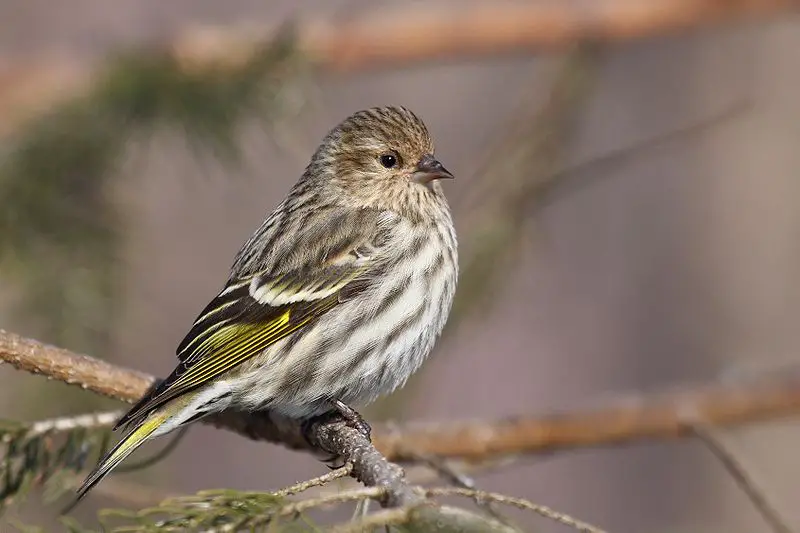
The Pine Siskin is a small bird from the finch family, primarily found in North America. It has an irregular migratory range and was first described by American ornithologist Alexander Wilson in 1810.
The species gets its name pinus, which means “pine-tree” in Latin, due to its frequent presence near coniferous trees.
Pine siskins are known for their yellow wing bars and streaked chests as well as their perky mannerisms when perched on branches or flying around looking for food during colder months.
They feed mostly on seeds of weeds, grasses and other plants but can also be seen consuming insects at times during summertime nesting season.
Its loud calls often alert nearby birds of potential danger while they nest high up among pine tree limbs where predators cannot reach them easily.Scientific classification:
| Kingdom | Animalia |
| Phylum | Chordata |
| Class | Aves |
| Order | Passeriformes |
| Family | Fringillidae |
| Subfamily | Carduelinae |
| Genus | Spinus |
| Species | S. pinus |
15. White-Crowned Sparrow
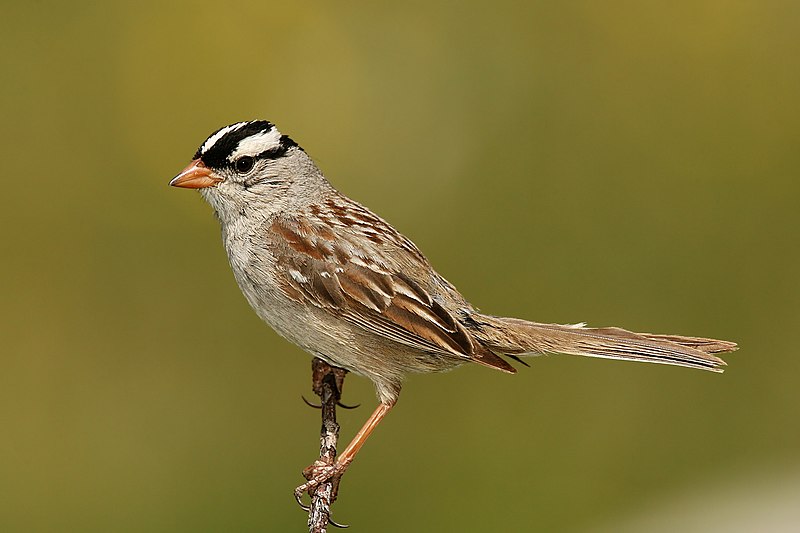
The White-crowned Sparrow is a species of passerine bird native to North America. It has a grey face and black and white streaking on its upper head, making it easy to identify.
This sparrow usually breeds in brushy areas located in the taiga, tundra, Rocky Mountains or Pacific coast regions of North America.
During winter months these birds migrate southward as far as Mexico and California where they can be found living amongst chaparral shrubbery or low bushes near open fields with plenty of seeds nearby.
The diet of this bird consists mainly of insects during summer while they switch over to eating grains like wheat & oats during colder months when bugs are scarce.
They are known for their characteristic chirp which sounds like “Oh sweet Canada Canada” drawing admirers from around the world.Scientific classification:
| Kingdom | Animalia |
| Phylum | Chordata |
| Class | Aves |
| Order | Passeriformes |
| Family | Passerellidae |
| Genus | Zonotrichia |
| Species | Z. leucophrys |
16. Red-Winged Blackbird

The red-winged blackbird is a beautiful bird found in most of North America and Central America.
Its distinct features include a glossy black body, with white shoulder patches and bright red wing coverts year round.
It prefers wetland habitats such as marshes, ponds, lakeshores and agricultural fields. During breeding season they inhabit grassy areas near water then move south for the winter months.
For food they mainly eat insects but also consume wild fruit or grains.
They are very social birds often seen in large flocks during migration times when their unmistakable “conk-la-ree” call can be heard echoing across the sky.Scientific classification:
| Kingdom | Animalia |
| Phylum | Chordata |
| Class | Aves |
| Order | Passeriformes |
| Family | Icteridae |
| Genus | Agelaius |
| Species | A. phoeniceus |
17. Black-Headed Grosbeak
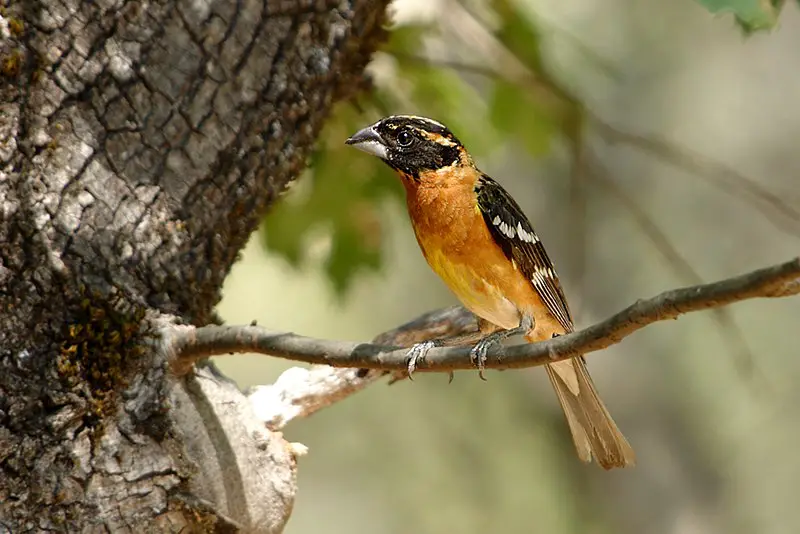
The Black-headed Grosbeak is a medium-sized bird that belongs to the Cardinalidae family. It has black head and upperparts, while its underparts are bright yellow.
This striking contrast makes it easy to distinguish from other birds. The grosbeak typically measures 19 cm in length and weighs around 47 grams.
During summer months, they migrate northward up into southwestern British Columbia for nesting grounds where they can find plenty of seeds as food sources.
They also hybridize with Rose-breasted Grosbeaks on the Great Plains in America, creating even more colorful plumage variations amongst these species.
All in all, this beautiful songbird will make an excellent addition to any backyard or garden if you’re lucky enough to spot one.Scientific classification:
| Kingdom | Animalia |
| Phylum | Chordata |
| Class | Aves |
| Order | Passeriformes |
| Family | Cardinalidae |
| Genus | Pheucticus |
| Species | P. melanocephalus |
18. Downy Woodpecker
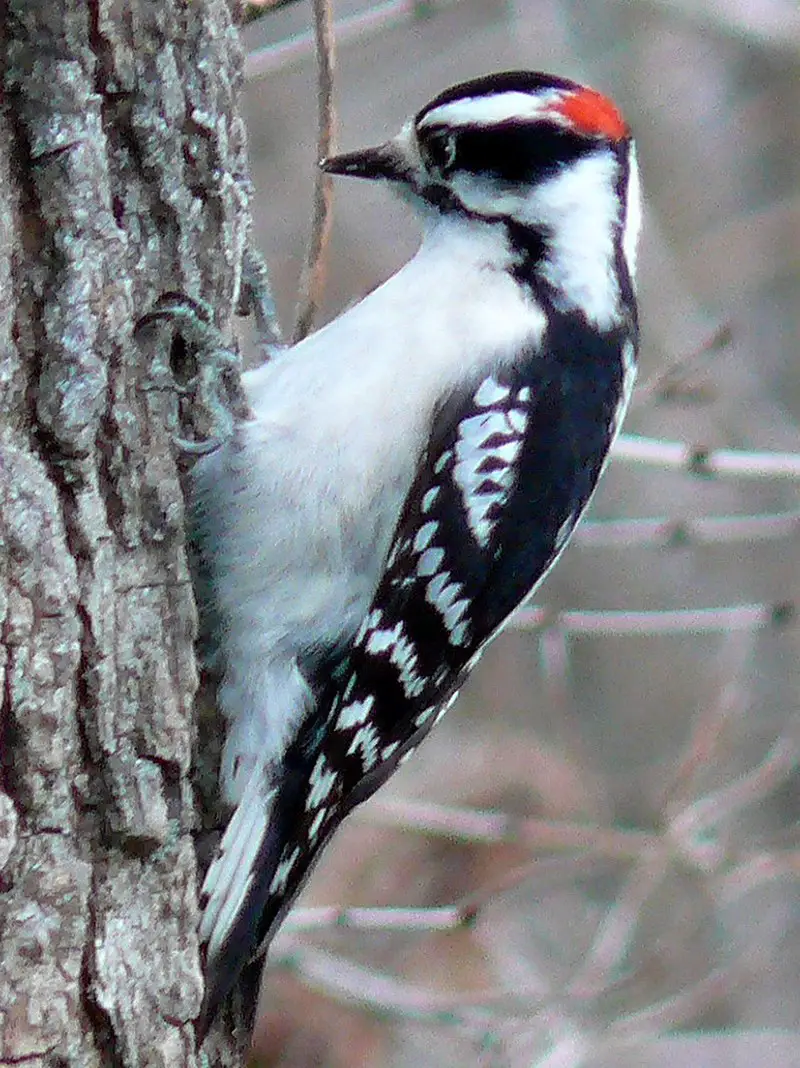
The downy woodpecker is a small species of woodpecker found in North America. Growing up to 7 inches long, it can be identified by its white belly and spotted wings.
It inhabits forests throughout the United States and Canada, with the exception of deserts in the southwest and northern tundra.
This bird nests in tree cavities and feeds mostly on insects but will supplement its diet with fruit or nuts when available.
The Downy Woodpecker has an unmistakable call that sounds like a loud ‘pik-er’, similar to other members of its family such as the Hairy Woodpecker.Scientific classification:
| Kingdom | Animalia |
| Phylum | Chordata |
| Class | Aves |
| Order | Piciformes |
| Family | Picidae |
| Genus | Dryobates |
| Species | D. pubescens |
19. Violet-Green Swallow
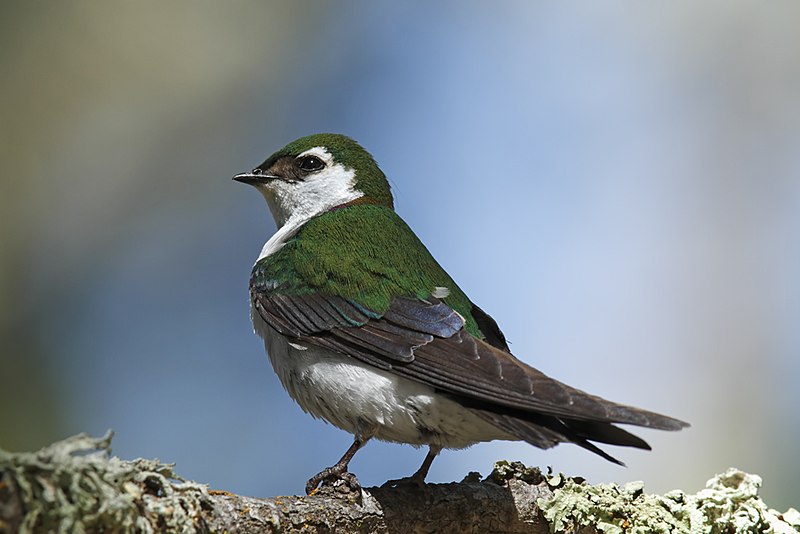
The Violet-green Swallow is a small, North American passerine bird belonging to the swallow family.
These birds are known for their aerial insectivorous diet and beautiful green coloration with white rump side patches that appear as if they’re separating it from other swallows.
They inhabit areas along the west coast of America, ranging from Alaska all the way down to Mexico and also extending eastwards to Montana and Texas.
This species can be seen swooping through open air in search of food or heard chirping away during its mating season – usually occurring between April till late summer months.
It’s an important part of many ecosystems due to its role in controlling insects populations.Scientific classification:
| Kingdom | Animalia |
| Phylum | Chordata |
| Class | Aves |
| Order | Passeriformes |
| Family | Hirundinidae |
| Genus | Tachycineta |
| Species | T. thalassina |
20. Rufous Hummingbird
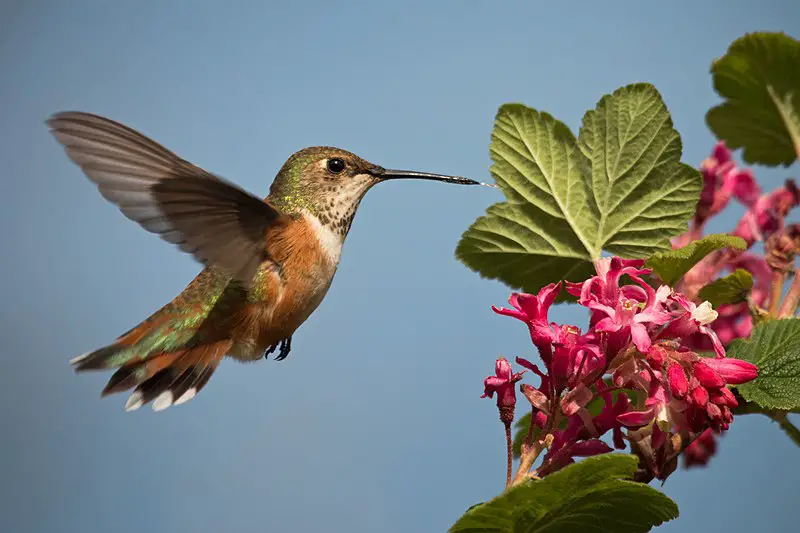
The beautiful Rufous Hummingbird is a small bird of 8 cm in length, with a long slender beak. It stands out due to its extraordinary flight skills and incredible migratory transits- they can fly up to 2,000 miles.
This species was formally described by German naturalist Johann Friedric in 1788 and belongs to the genus Selasphorus.
These birds are found all over North America and parts of Mexico during summertime; while wintering in Central America or northern South America.
They feed on nectar from flowers as well as insects for protein intake. With their vibrant feathers, agile flying abilities and fascinating life cycle they make an interesting addition to any backyard wildlife habitat.Scientific classification:
| Kingdom | Animalia |
| Phylum | Chordata |
| Class | Aves |
| Order | Apodiformes |
| Family | Trochilidae |
| Genus | Selasphorus |
| Species | S. rufus |
21. Varied Thrush
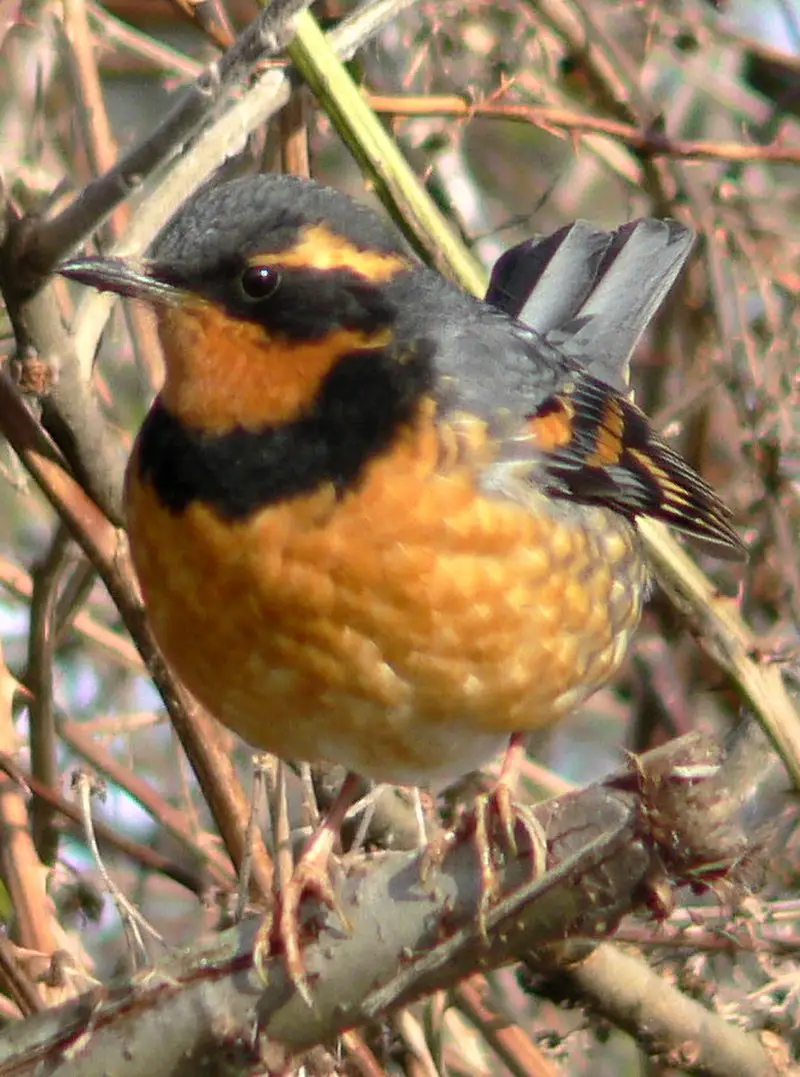
The Varied Thrush (Ixoreus naevius) is the only species in its genus and belongs to the thrush family, Turdidae.
It was first described by German naturalist Johann Friedrich Gmelin in 1789 as Turdus naevius , based on a specimen owned by John Latham which had been described as “Spotted Thrush” four years earlier.
This bird has an olive-brown back with reddish streaks along white underparts; it also bears spots of yellow or orange colouring across its chest.
Its wings are black with bold white patches while its tail appears long and pointed at times when spread out during flight.
The varied thrush can be found throughout western North America from Alaska southwards into California, Arizona, New Mexico and northern Mexico where they prefer habitats such as coniferous forests and mountain areas near streams or rivers for their habitat.
They feed mainly on insects but will also eat fruits if available making them omnivorous birds.Scientific classification:
| Kingdom | Animalia |
| Phylum | Chordata |
| Class | Aves |
| Order | Passeriformes |
| Family | Turdidae |
| Genus | Ixoreus Bonaparte, 1854 |
| Species | I. naevius |
22. Ruby-Crowned Kinglet
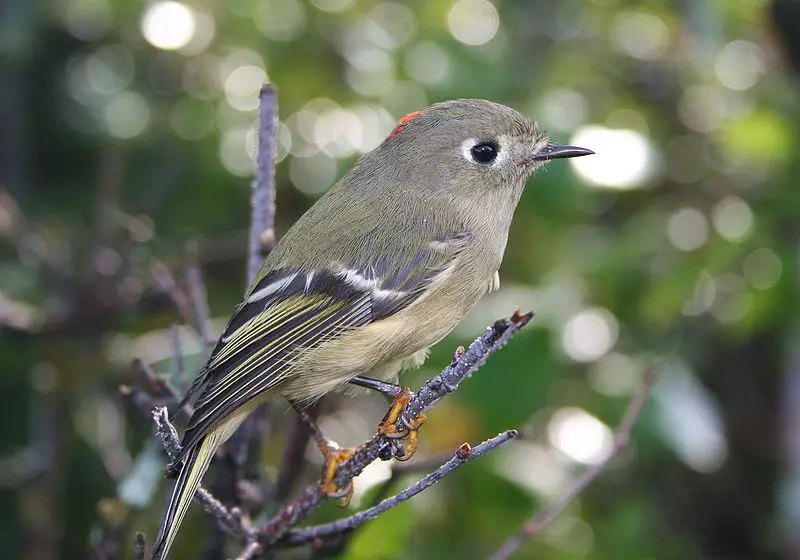
The Ruby-crowned Kinglet is a small passerine bird native to North America. It has olive green plumage, white wing bars and an eye-ring as well as a distinctive red crown patch on the males.
Juveniles look similar to adults with no distinguishing features other than size.
They are usually found in coniferous forests or woodlands where they spend much of their time searching for insects among foliage and branches while constantly flitting from place to place.
These birds have incredible energy levels that allow them to travel long distances during migration season without getting exhausted too quickly, making them one of nature’s most resilient species.Scientific classification:
| Kingdom | Animalia |
| Phylum | Chordata |
| Class | Aves |
| Order | Passeriformes |
| Family | Regulidae |
| Genus | Corthylio Cabanis, 1853 |
| Species | C. calendula |
23. Yellow-Rumped Warbler

The Yellow-rumped Warbler (Setophaga coronata) is a migratory bird species that can be found throughout North America.
It has an extensive range, from the Pacific and Atlantic coats of the US to Canada and Central America, with a concentration in northern areas during breeding season.
These birds migrate southwards for wintering grounds where they find plentiful food sources such as insects and berries.
They are easily identified by their yellow patches on either side of their tails, along with white underparts, gray back feathers and two distinct crown stripes.
One black or greyish-brown above the eyes extending towards its neck banded in yellow or light brown colouration.
Furthermore, these warblers have strong legs which allow them to cling onto branches while hunting for prey making them adept at maneuvering through tree cover quickly.
All together this makes the Yellow-rumped Warbler an attractive backyard visitor year round.Scientific classification:
| Kingdom | Animalia |
| Phylum | Chordata |
| Class | Aves |
| Order | Passeriformes |
| Family | Parulidae |
| Genus | Setophaga |
| Species | S. coronata |
24. Brown Creeper
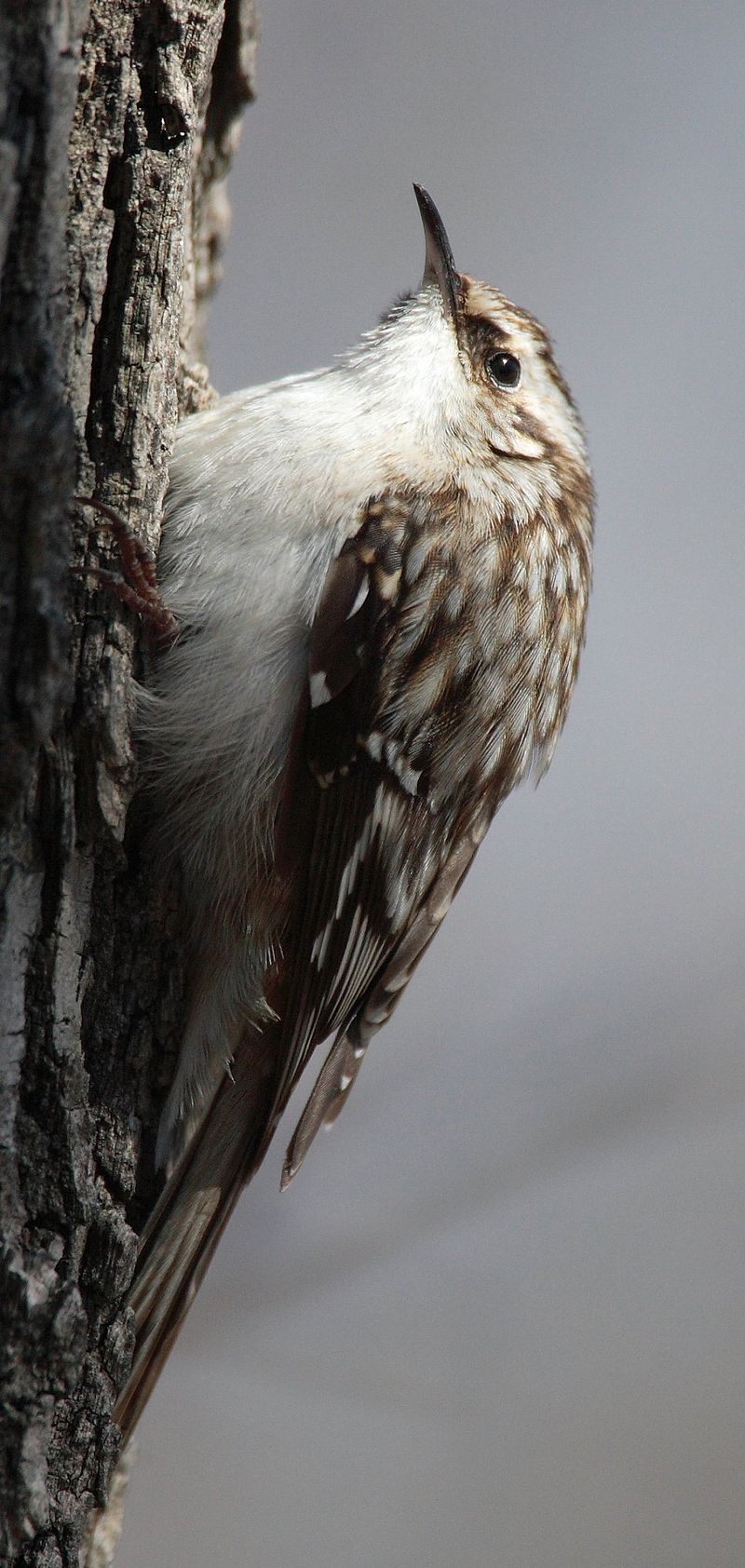
The Brown Creeper is a small songbird belonging to the Certhiidae family and is native to North America. It has brown upperparts with light spotting that resembles tree bark, as well as white underparts.
Its bill is long and thin with a slight downward curve while its tail is also long yet stiff; this helps it creep up trees.
This bird feeds mainly on insects which can be found in crevices of barks or dead plants, thanks to its curved bill which allows it access these hard-to-reach places.
When searching for food they move diagonally upwards around trunks so their camouflage blends in perfectly with the background making them difficult to spot.Scientific classification:
| Kingdom | Animalia |
| Phylum | Chordata |
| Class | Aves |
| Order | Passeriformes |
| Family | Certhiidae |
| Genus | Certhia |
| Species | C. americana |
25. Canada Jay
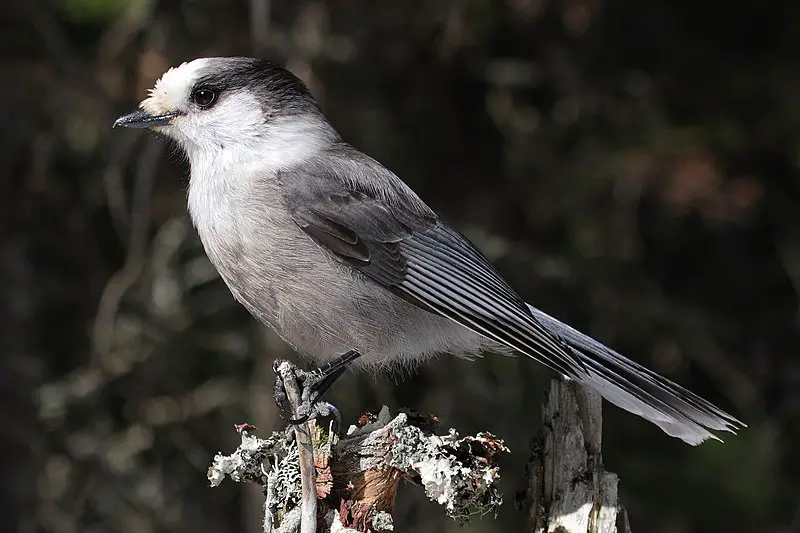
The Canada jay is a beautiful bird that can be found in many parts of North America. It has pale grey underparts and darker grey upperparts, making it easy to identify from other birds.
Its wingspan typically measures around 13 inches long and its body length up to 9 inches, giving it the nickname ‘Whiskey Jack’ or ‘Camp Robber’.
These birds are usually seen foraging on the ground for food like fruits and small insects, although they also eat carrion, eggs and nestlings when available.
They often store their collected food in caches hidden among branches near their nests as well as trees throughout their territories during winter months.
Their high intelligence makes them very adaptive scavengers who survive harsh winters while still being able to take advantage of summer bounty.
All these traits make this species one of nature’s most fascinating creatures.Scientific classification:
| Kingdom | Animalia |
| Phylum | Chordata |
| Class | Aves |
| Order | Passeriformes |
| Family | Corvidae |
| Genus | Perisoreus |
| Species | P. canadensis |
26. Sandhill Crane
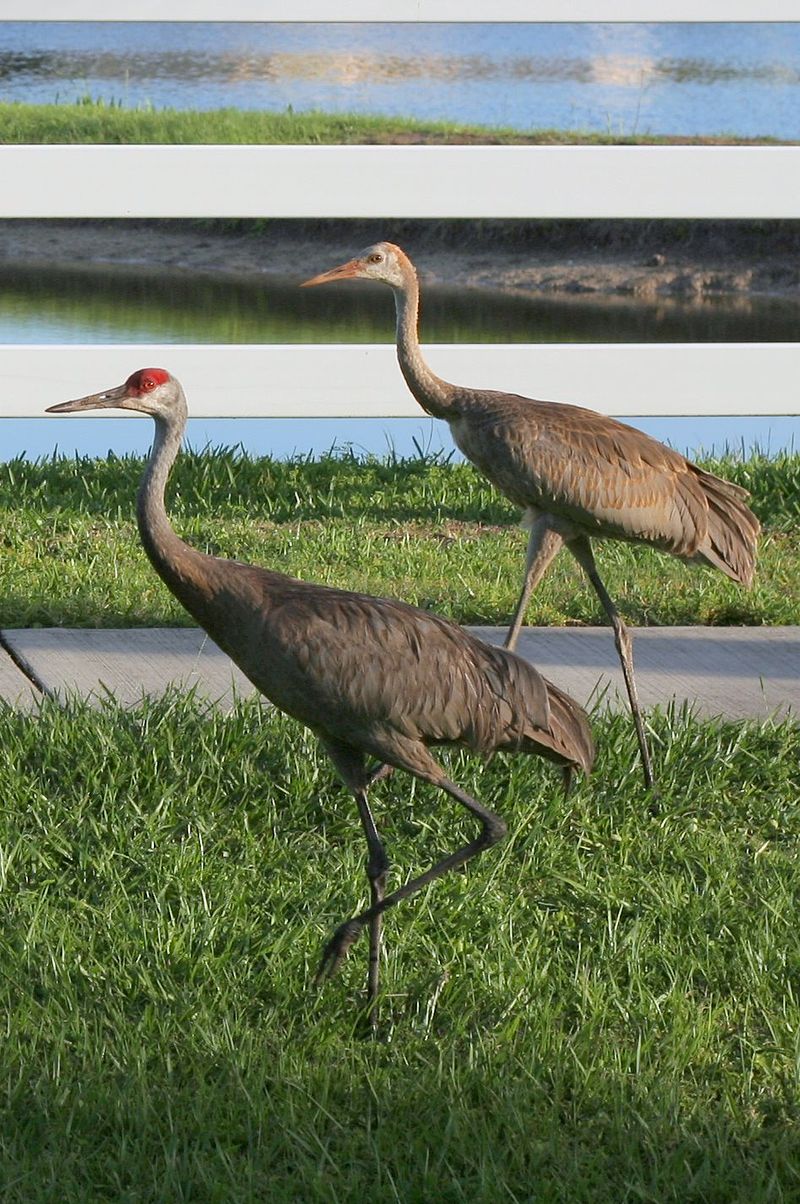
Sandhill Cranes are a large species of crane native to North America and northeastern Siberia. They are known for their distinctive calls, long legs, and long necks.
These birds typically inhabit wetland areas like the Platte River in Nebraska’s Sandhills on the Great Plains.
In Central Florida, they often gather at the edges of bodies of water such as lakes or rivers.
During breeding season, sandhill cranes can be seen performing elaborate courtship dances that involve bowing and jumping in unison with their partner.
Their diet consists mainly of plant material including grains, roots, tubers and aquatic plants which they obtain by pecking or digging into mudflats using their bill or feet respectively.
With an average lifespan between 10-20 years these majestic creatures make great additions to any wetland habitat.Scientific classification:
| Kingdom | Animalia |
| Phylum | Chordata |
| Class | Aves |
| Order | Gruiformes |
| Family | Gruidae |
| Genus | Antigone |
| Species | A. canadensis |
27. White-Breasted Nuthatch

The White-breasted Nuthatch is a medium-sized bird belonging to the nuthatch family Sittidae. It measures around 15.5 cm in length and its colour varies throughout its range.
Males have a light blue-grey upperpart, with black crown and nape whereas females have a dark grey crown instead of black one.
The underparts are whitish, with reddish tinge on sides and flanks while the bill is short and stout with pale base near eyes which can be yellow or white depending upon geographic location..
This species feeds mainly on insects but will also eat seeds, nuts and berries when available.
They prefer open woodlands where they often climb trees searching for food along trunks as well as branches underneath bark crevices creating their nest there too.Scientific classification:
| Kingdom | Animalia |
| Phylum | Chordata |
| Class | Aves |
| Order | Passeriformes |
| Family | Sittidae |
| Genus | Sitta |
| Species | S. carolinensis |
28. Swainson’s Thrush
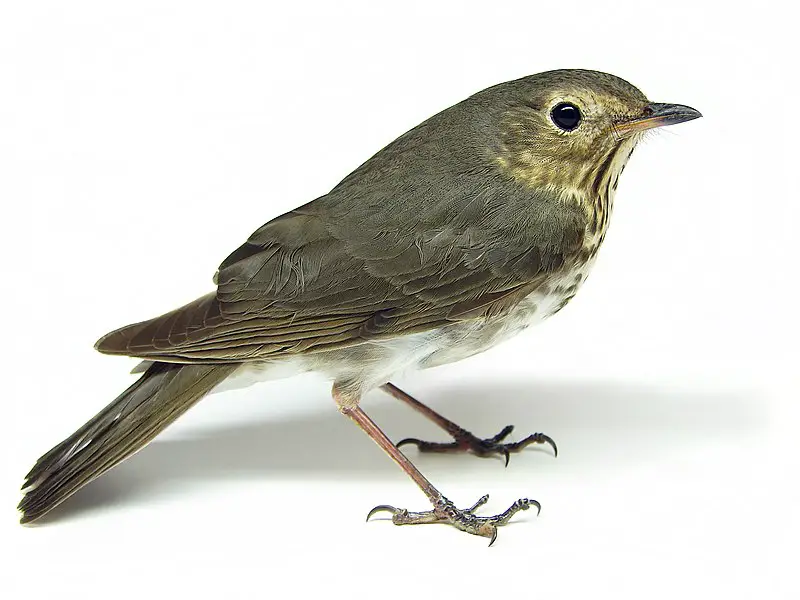
Swainson’s thrush is a medium-sized bird that belongs to the Catharus genus. Its coloration is subdued and its voice has been described as being flute-like, making it an appealing addition to any backyard.
It was named after William Swainson, an English ornithologist from the 19th century. The name of this species comes from Ancient Greek katharos which means “pure” or “clean” – appropriate for such a beautiful creature.
This type of thrush can be found throughout North America in habitats ranging from coniferous forests to open fields with scattered trees and shrubs; they also migrate south during winter months.
Despite their beauty, these birds are declining due to habitat loss and fragmentation so we must work together if we want them around forever.Scientific classification:
| Kingdom | Animalia |
| Phylum | Chordata |
| Class | Aves |
| Order | Passeriformes |
| Family | Turdidae |
| Genus | Catharus |
| Species | C. ustulatus |
29. Golden-Crowned Sparrow
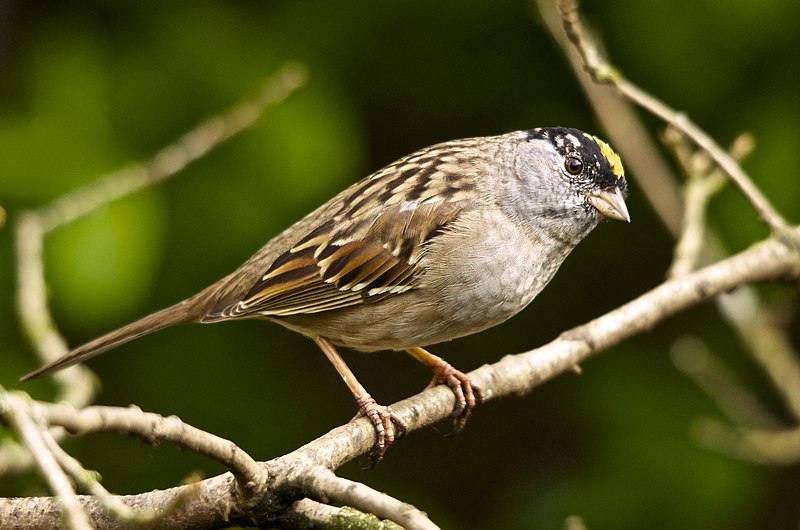
The golden-crowned sparrow is a large New World bird found in the western part of North America. It belongs to the genus Zonotrichia, made up of five species and has no subspecies.
This bird is closely related to the white-crowned sparrow as studies show their mitochondrial DNA evolves at a similar rate.
The most recognizable feature on this beautiful creature are its distinctive yellow stripes near its forehead that appear almost like an orange crown when seen from afar.
Its plumage can range from grey browns in winter months, to dull yellows and oranges during breeding season which typically occurs between April and July.
These birds are often seen foraging through leaf litter or along grassy fields looking for seeds, insects and berries to eat while they sing sweet melodies throughout their habitat.Scientific classification:
| Kingdom | Animalia |
| Phylum | Chordata |
| Class | Aves |
| Order | Passeriformes |
| Family | Passerellidae |
| Genus | Zonotrichia |
| Species | Z. atricapilla |
30. Western Kingbird
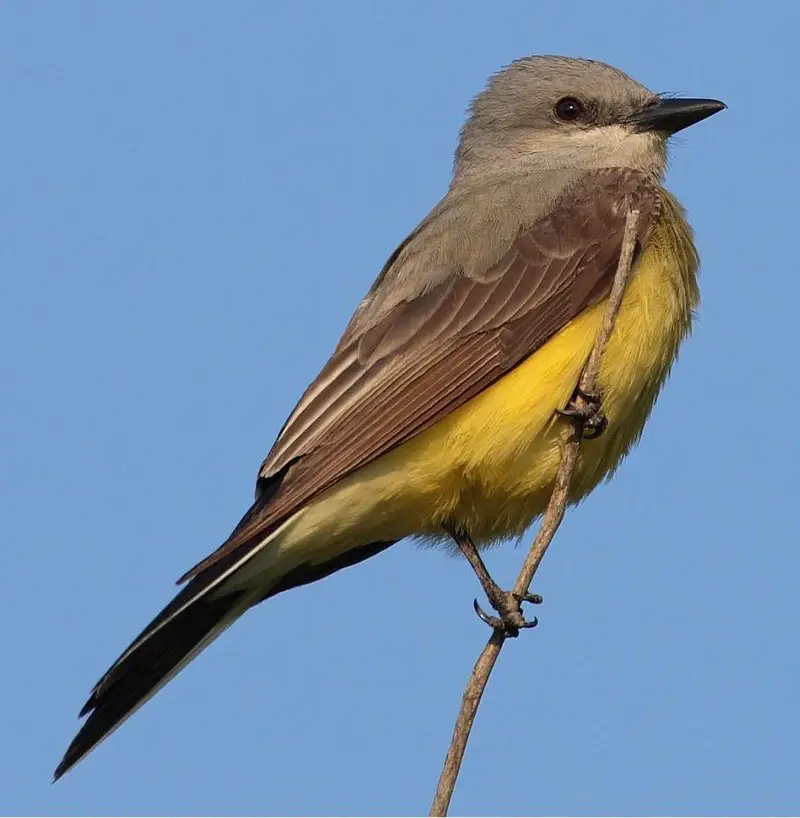
The Western kingbird is a large tyrant flycatcher native to western North America. It has striking plumage, with gray and yellow feathers tinged with crimson during courtship or when defending territory from intruders.
As is characteristic of its kind, the Western Kingbird exhibits highly territorial behavior towards other birds in its area.
They are found as far south as Mexico, inhabiting open habitats near bodies of water such as rivers and lakes.
While their primary diet consists of insects like bees and flies that they catch mid-flight, it also includes fruit for variety during winter months.
The species have recently seen an increase in population due to conservation efforts which aim to protect these beautiful creatures.Scientific classification:
| Kingdom | Animalia |
| Phylum | Chordata |
| Class | Aves |
| Order | Passeriformes |
| Family | Tyrannidae |
| Genus | Tyrannus |
| Species | T. verticalis |
31. Cooper’s Hawk
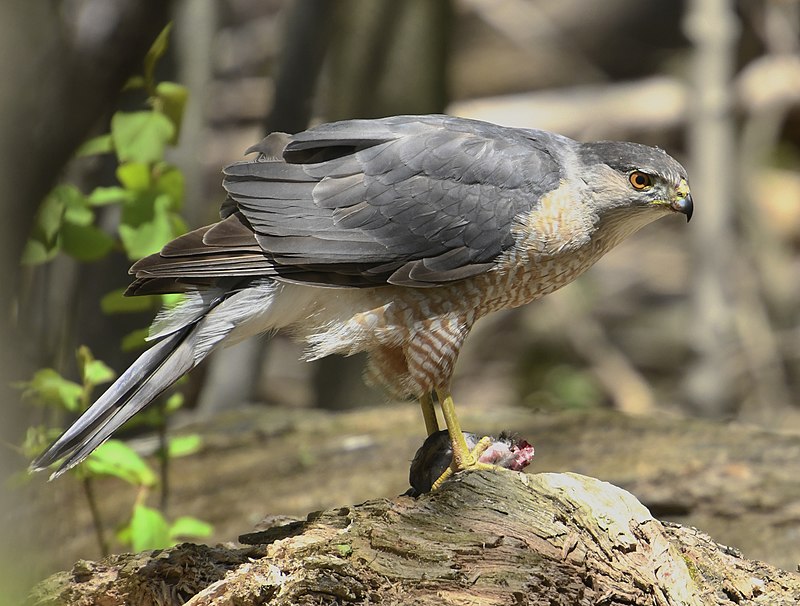
Cooper’s Hawk is a medium-sized bird of prey native to North America. It belongs to the Accipiter genus, which are known for their agility and small size compared to other hawks.
They usually inhabit wooded areas, making them well-adapted hunters in dense environments.
Cooper’s Hawks have rounded wings with short tails that help them maneuver quickly through trees when chasing after prey such as small rodents or birds.
These raptors also possess powerful feet equipped with sharp talons used for catching food items on the ground and even out of midair.
The adult plumage has barred upperparts, ranging from greyish brown on lighter individuals up to dark chestnut colors found in darker specimens; they also display rusty underparts marked by thin white streaking down either side of their chests and bellies.Scientific classification:
| Kingdom | Animalia |
| Phylum | Chordata |
| Class | Aves |
| Order | Accipitriformes |
| Family | Accipitridae |
| Genus | Accipiter |
| Species | A. cooperii |
32. Common Yellowthroat

The Common Yellowthroat is a small, New World Warbler found throughout North America. It has distinctive yellow and black plumage that earned it the nickname “Yellow Bandit” in the Midwest United States.
This species is highly adaptable and can be found inhabiting wetlands, grasslands, shrub-land habitats, as well as suburban areas.
The genus of this bird’s scientific name translates to mean ‘ground’ and ‘small bird’, which are fitting characteristics for such an elusive yet common little creature.
Its diet consists predominantly of insects but may also include other invertebrates like spiders or worms.
Overall the Common Yellowthroat makes an excellent addition to any backyard with its cheerful song.Scientific classification:
| Kingdom | Animalia |
| Phylum | Chordata |
| Class | Aves |
| Order | Passeriformes |
| Family | Parulidae |
| Genus | Geothlypis |
| Species | G. trichas |
33. Bullock’s Oriole
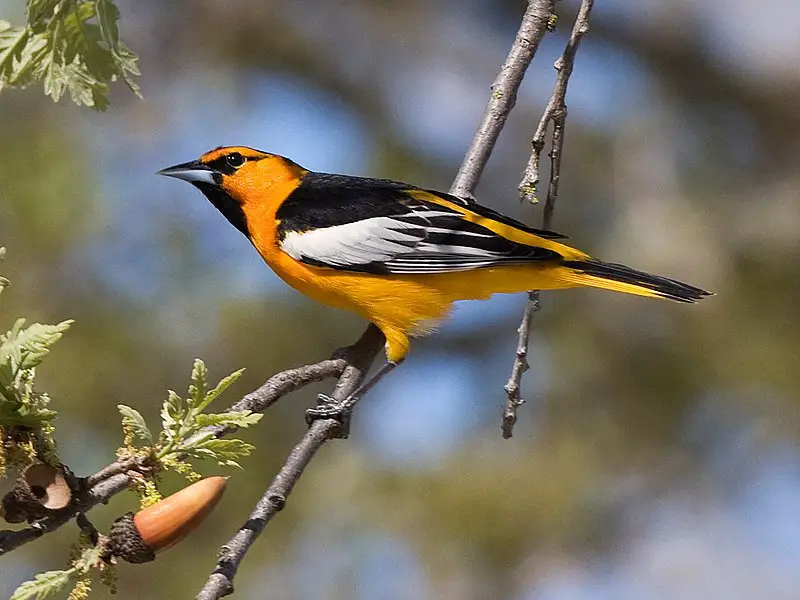
Bullock’s oriole is a small, sexually dimorphic New World blackbird that was once thought to be the same species as Baltimore Oriole. It was named after William Bullock, an English amateur naturalist.
Male birds are more brightly colored and slightly larger than females. These birds typically have yellow heads and wings with dark brown or black bodies with white bars on their backs and tails.
They can often been seen perched high up in trees foraging for insects among foliage or singing from branches during mating season.
Their diet consists of mostly fruits such as oranges, apples, plums; they also eat some seeds like millet along with grasshoppers and other insects when available.
The Bullock’s oriole is found throughout western North America in areas of woodland scrubland which provide it shelter from predators while providing plenty food sources to sustain itself year round.Scientific classification:
| Kingdom | Animalia |
| Phylum | Chordata |
| Class | Aves |
| Order | Passeriformes |
| Family | Icteridae |
| Genus | Icterus |
| Species | I. bullockii |
34. Common Loon
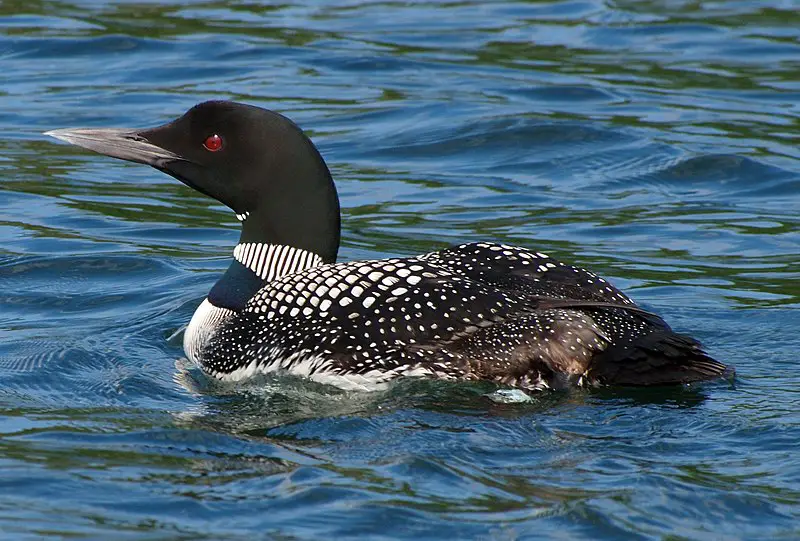
The Common Loon is a beautiful bird found in North America. It has a large black head and neck, with a greenish to purple sheen that stands out against its dark grey upperparts.
The underparts are pure white except for some black on the undertail coverts and vent.
During non-breeding season adults have brown plumage instead of the bright shades they show during breeding season.
They also exhibit unique behaviors such as diving underwater to catch fish or swimming along lakeshores while calling loudly, which is how they got their name “great northern diver”.
With their stunning colors and interesting behavior, it’s no wonder why these birds make up an iconic part of many landscapes across North America.Scientific classification:
| Kingdom | Animalia |
| Phylum | Chordata |
| Class | Aves |
| Order | Gaviiformes |
| Family | Gaviidae |
| Genus | Gavia |
| Species | G. immer |
35. Wrens
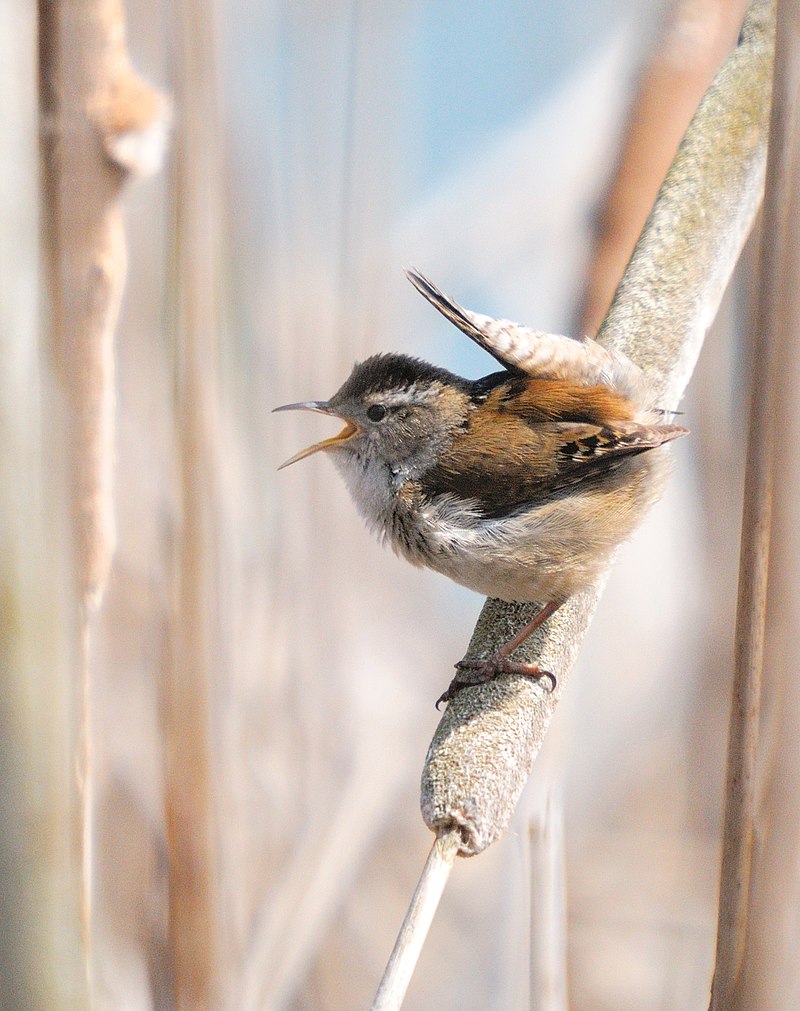
Wrens are a family of small brown passerine birds found mainly in the Americas. They are considered one of the most abundant bird species, with 88 known varieties divided into 19 genera.
The Eurasian wren is the only type that inhabits Europe and other parts of the Old World, where it’s commonly referred to simply as “wren.”
This species has been given its name due to similar-looking unrelated birds living elsewhere such as New Zealand wrasses.
Wrens have tiny bodies with thin bills and long tails which they often hold upright for hours at a time while singing their loud cheery songs from treetops or low shrubs.
Their diet consists mostly of insects but can also include fruits and seeds depending on availability in their habitat range.Scientific classification:
| Kingdom | Animalia |
| Phylum | Chordata |
| Class | Aves |
| Order | Passeriformes |
| Superfamily | Certhioidea |
| Family | Troglodytidae Swainson, 1832 |
36. Summer Tanager
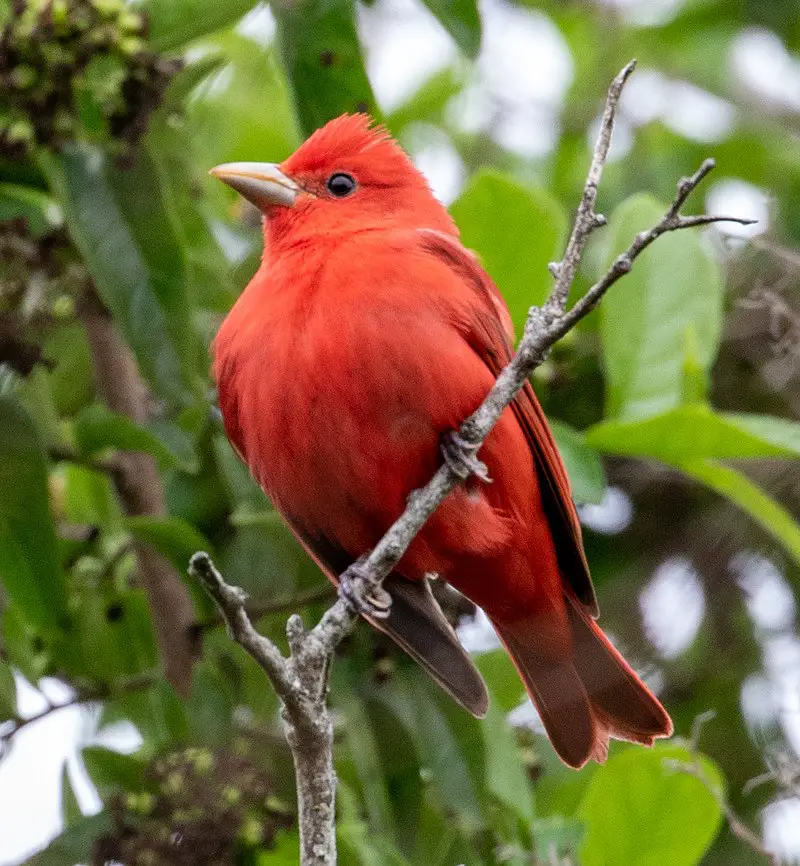
The Summer Tanager is a stunningly beautiful member of the cardinal family. Native to North and South America, this medium-sized songbird features striking red plumage on its back with yellow underparts.
It has a pointed black bill and long tail feathers that can be seen fluttering through the air when it flies.
The species’ vocalizations are quite similar to those of other members of its genus as well, which often include short whistles and chirps in addition to longer songs made up of various phrases or syllables.
With their vibrant colors and melodic voices, these birds make an eye-catching sight any time they appear.Scientific classification:
| Kingdom | Animalia |
| Phylum | Chordata |
| Class | Aves |
| Order | Passeriformes |
| Family | Cardinalidae |
| Genus | Piranga |
| Species | P. rubra |
37. Bewick’s Wren
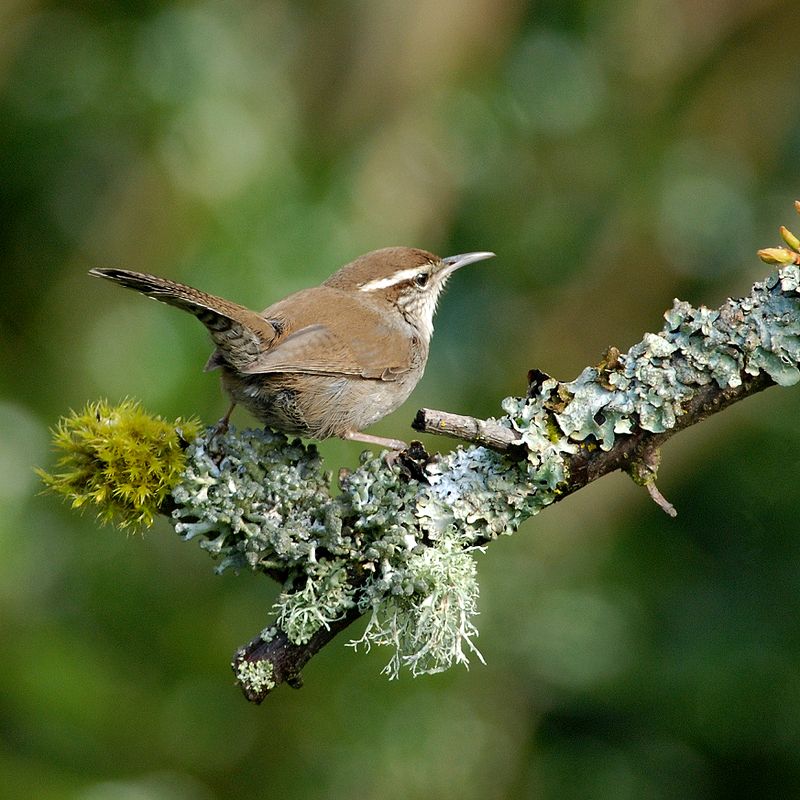
The Bewick’s wren (Thryomanes bewickii) is a small, grey-brown bird native to North America. Measuring at around 14 cm long it has distinctive white markings on its face and tail giving it an attractive appearance.
It can often be found in thickets or scrubby areas as well as urban gardens and parks.
Its song is loud and melodious which makes them popular amongst ornithologists; they are known for their complex vocalisations composed of whistles, clicks, churrs and trills.
The Bewick’s Wren mainly feeds on insects but will also eat fruits if available during the colder months when food may otherwise be scarce.
This species of wren plays an important role in controlling insect populations making them beneficial inhabitants of our environment.Scientific classification:
| Kingdom | Animalia |
| Phylum | Chordata |
| Class | Aves |
| Order | Passeriformes |
| Family | Troglodytidae |
| Genus | Thryomanes P.L. Sclater, 1862 |
| Species | T. bewickii |
38. Belted Kingfisher
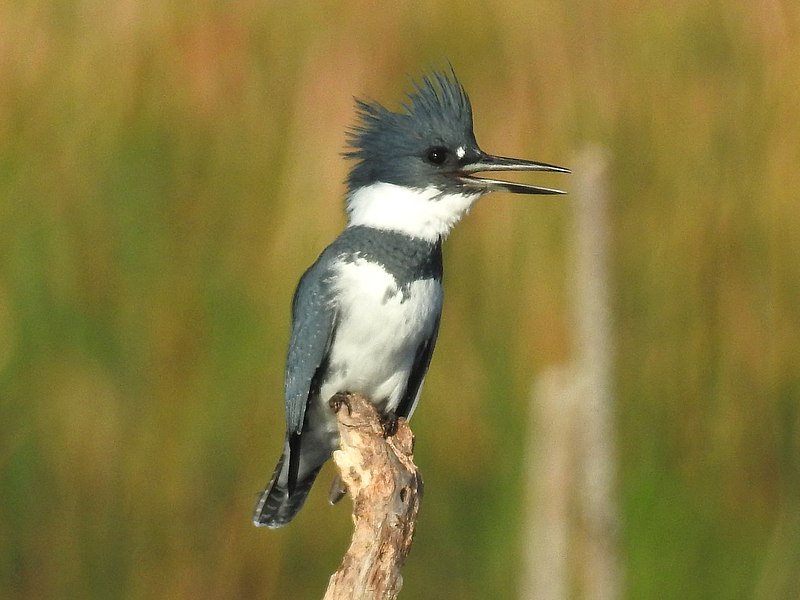
The belted kingfisher is a large, eye-catching bird native to North America. It belongs to the family Alcedinidae and has been divided into three subfamilies by recent research.
The species was first described in 1758 by Carl Linnaeus in his Systema Naturae.
This water Kingfisher stands out for its size as well as its striking plumage; males are bright blue on top with white below and females have rusty brown backs and wings with a thick black breast band across their chest.
They also possess an impressive call which can be heard from quite far away.
Belted kingfishers feed mainly on small fish but will sometimes also eat crustaceans, insects or even amphibians if they come across them while hunting around rivers or streams.
All in all, this is truly one remarkable bird that deserves our admiration.Scientific classification:
| Kingdom | Animalia |
| Phylum | Chordata |
| Class | Aves |
| Order | Coraciiformes |
| Family | Alcedinidae |
| Subfamily | Cerylinae |
| Genus | Megaceryle |
| Species | M. alcyon |
39. Red-Tailed Hawk
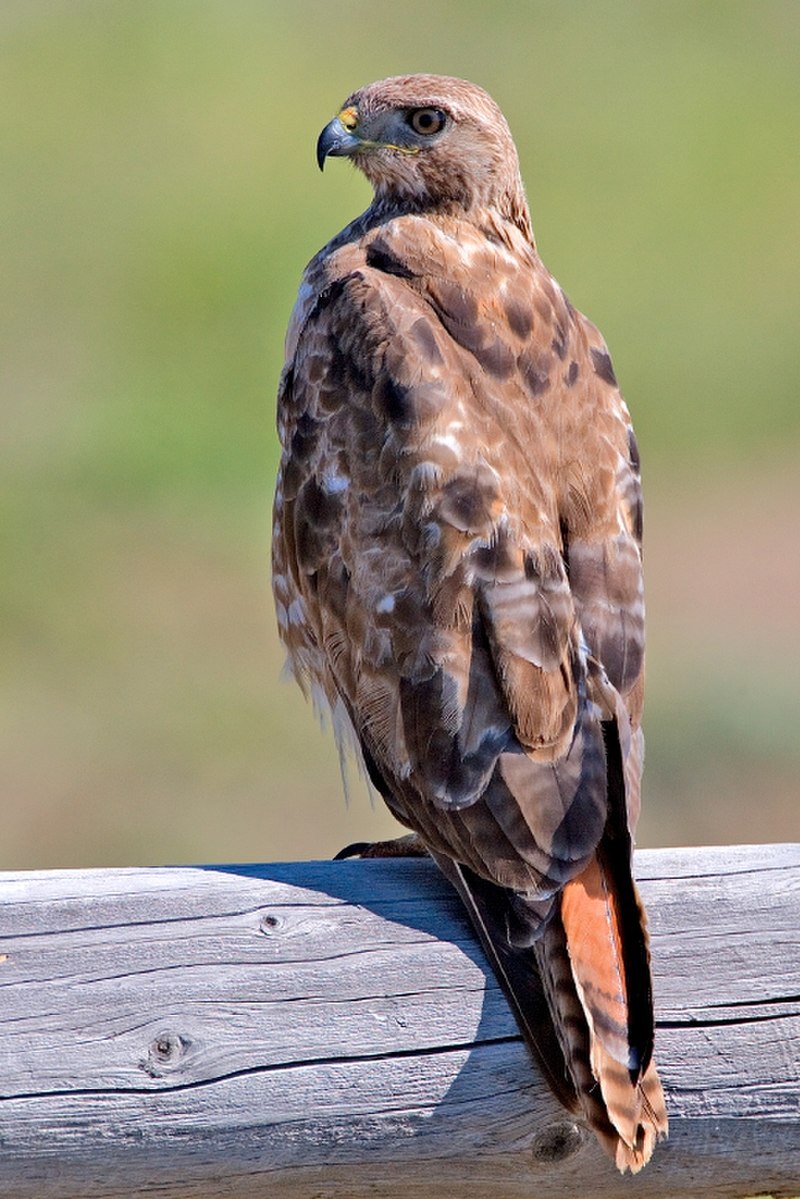
The Red-tailed Hawk is a majestic bird of prey with its distinctive red tail. It can be found throughout North America, from Alaska in the north to Panama and the West Indies in the south.
This species belongs to Buteo genus, which makes it one of most common raptors on earth.
These hawks mainly hunt small mammals such as rabbits or squirrels but also feed on reptiles and birds during migration season.
Unlike other predator birds, they prefer open areas for hunting like fields or grasslands rather than dense forests.
They build their nests high up on trees where they stay all year long unless disturbed by humans or animals nearby.
Their presence has become an iconic part of American culture due to their frequent sightings around homes and parks alike making them beloved creatures among people everywhere.Scientific classification:
| Kingdom | Animalia |
| Phylum | Chordata |
| Class | Aves |
| Order | Accipitriformes |
| Family | Accipitridae |
| Genus | Buteo |
| Species | B. jamaicensis |
40. Brown-Headed Cowbird
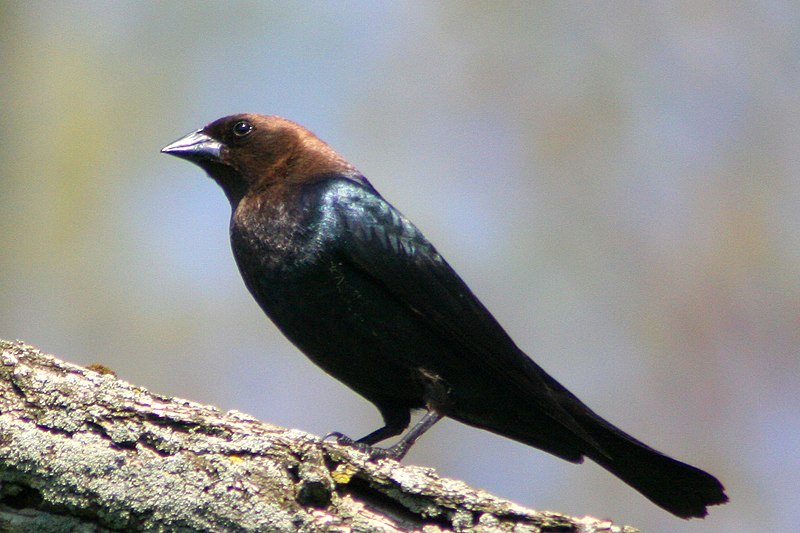
The Brown-headed Cowbird is a small, obligate brood parasitic icterid native to temperate and subtropical North America. It has a brown head with glossy black plumage on the body, wings and tail feathers.
During summer months it can be found in prairies, grasslands as well as open wooded areas but during winter they migrate southwards towards the United States of Mexico for warmer climate.
They are mainly insectivorous birds which feed on insects like caterpillars or beetles but also consume some grains too.
The female bird lays its eggs in nests of other species who then incubates them until hatching time thus leaving their own chicks uncared for by themselves.Scientific classification:
| Kingdom | Animalia |
| Phylum | Chordata |
| Class | Aves |
| Order | Passeriformes |
| Family | Icteridae |
| Genus | Molothrus |
| Species | M. ater |
41. Grey Plover
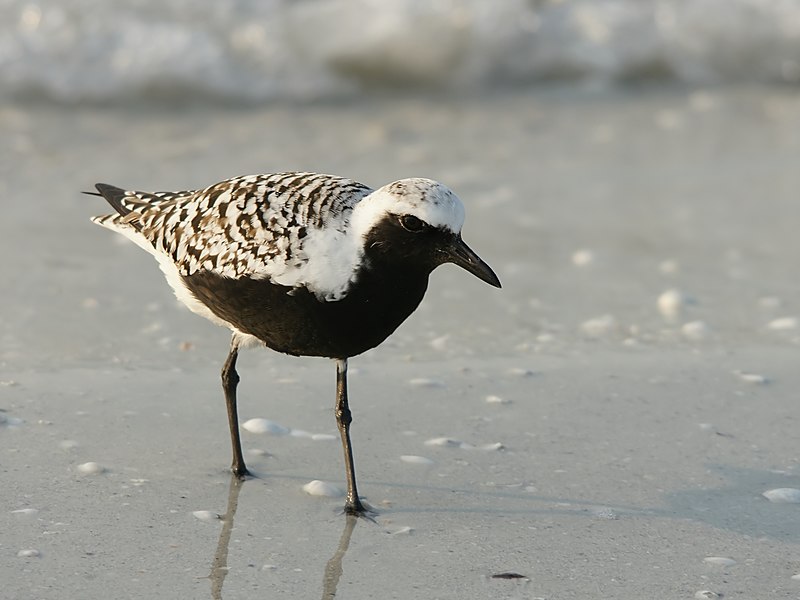
The Grey Plover is a large plover bird which breeds in the Arctic regions. It then migrates over long distances, and can be found on coastlines around the world when not breeding.
The species was first described by Swedish naturalist Carl Linnaeus in 1758 under its binomial name “Tringa squatarola”.
In addition to being known as grey plovers or black-bellied plovers, they are also sometimes referred to as “black-breasted lapwings” due to their distinctive plumage that features white underneath with dark greys above.
These birds inhabit beaches, mudflats and saltmarshes where they feed mainly on small invertebrates such as worms and insects.Scientific classification:
| Kingdom | Animalia |
| Phylum | Chordata |
| Class | Aves |
| Order | Charadriiformes |
| Family | Charadriidae |
| Genus | Pluvialis |
| Species | P. squatarola |
42. Hutton’s Vireo
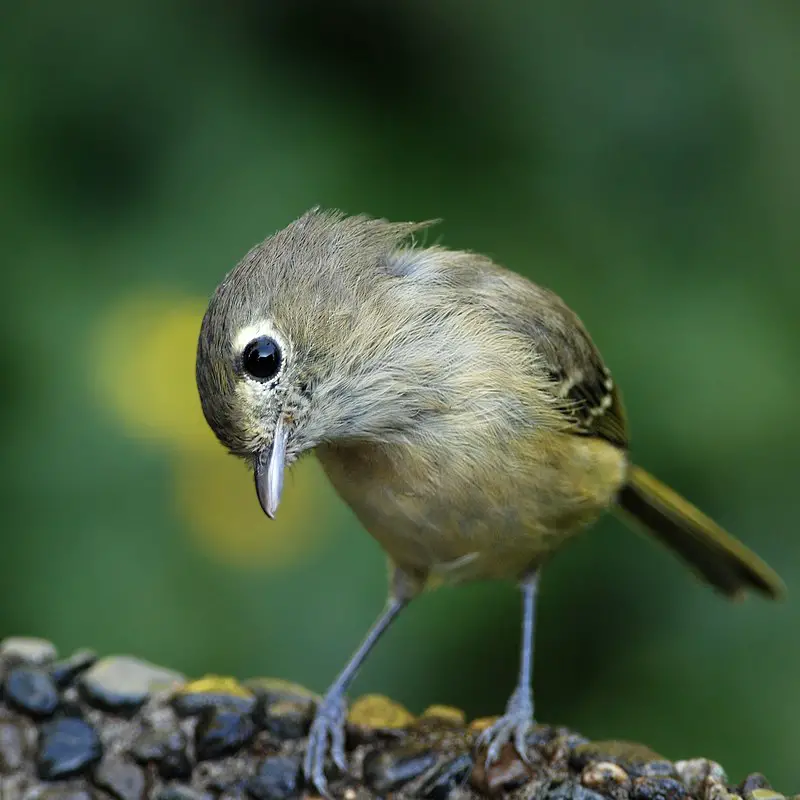
Hutton’s Vireo is a small songbird that closely resembles the Ruby-Crowned Kinglet. It has an olive gray color and can grow up to 12–13 cm in length, with a thicker bill, blue-gray legs and faint white eye ring and wing bars.
Its most distinguishable feature is its call which consists of a repeated chu-wee or chew sound.
This bird mainly feeds on insects such as flies, moths, beetles among other things but it also eats some berries too like serviceberry or elderberry fruits during wintertime.
They are usually found in open woodlands near riversides at elevations between 500 -2 000 meters above sea level where they breed from May until September making them migratory birds during winter months when food becomes scarce.Scientific classification:
| Kingdom | Animalia |
| Phylum | Chordata |
| Class | Aves |
| Order | Passeriformes |
| Family | Vireonidae |
| Genus | Vireo |
| Species | V. huttoni |
Also Featured In: Common Birds of Mexico City,
43. Calliope Hummingbird
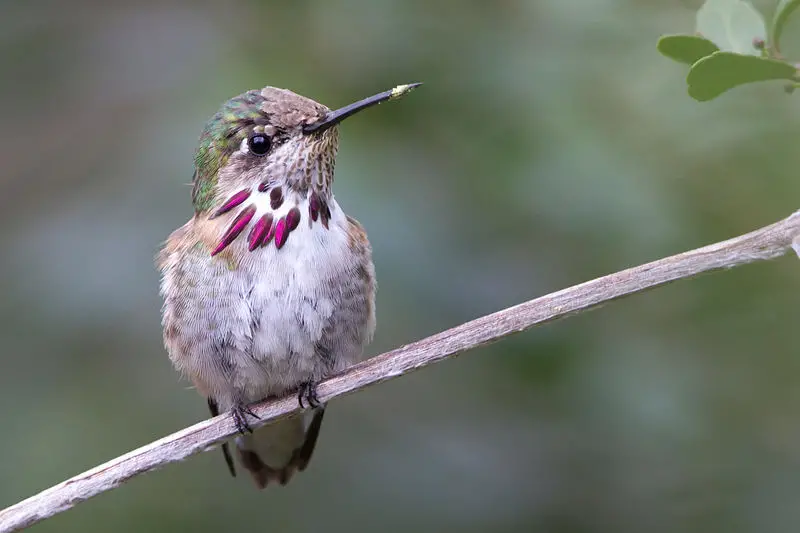
The Calliope hummingbird is the tiniest bird native to North America, stretching from California up through British Columbia.
During winter it will travel all the way down as far south as Mexico and Central America before returning north for breeding season.
It was previously thought to be the only member of its genus Stellula but recently has been reclassified under Selasphorus due to genetic similarities with other birds in that group.
Its bright colors are an unmistakable sight and they love sipping on nectar from flowers or sugar water feeders placed outside windows.
They’re a popular delight among both wildlife photographers and amateur bird enthusiasts alike.Scientific classification:
| Kingdom | Animalia |
| Phylum | Chordata |
| Class | Aves |
| Order | Apodiformes |
| Family | Trochilidae |
| Genus | Selasphorus |
| Species | S. calliope |
44. California Scrub Jay
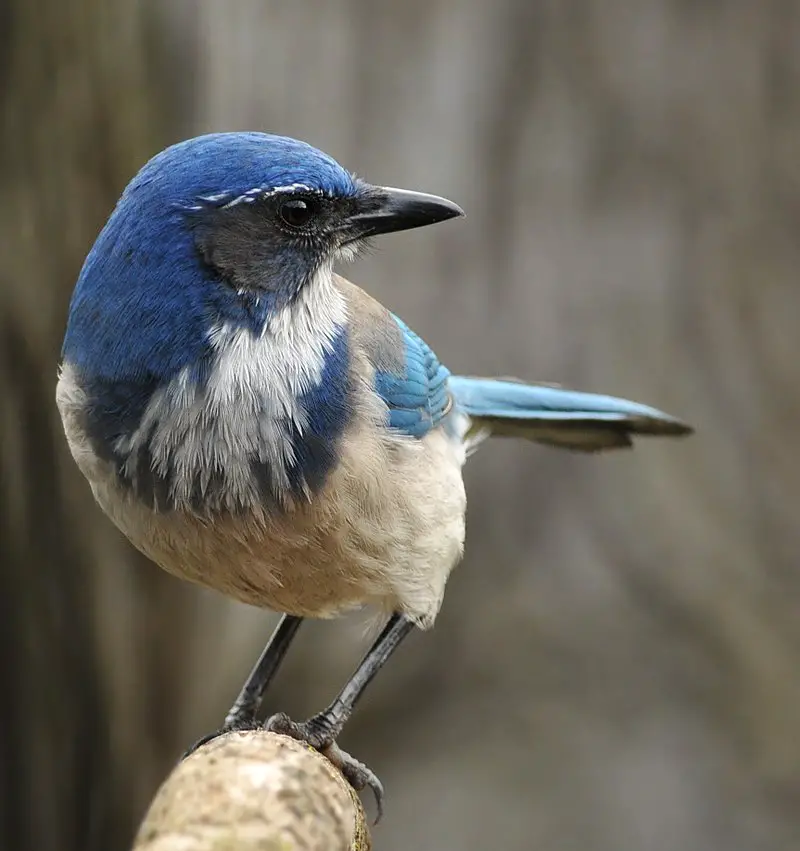
The California scrub jay is a species of bird native to western North America. It can be found from southern British Columbia all the way down through California and western Nevada near Reno, up to west beyond the Sierra Nevada range.
This beautiful blue feathered bird was once categorized with Woodhouse’s scrub jay as the “western scrub jay” along with island scrub jays.
The California Scrub Jay has distinctive features such as its greyish-blue feathers on its head, wings and tail; white cheeks; dark bill; and strong legs for perching in trees which makes it stand out among other birds in its family.Scientific classification:
| Kingdom | Animalia |
| Phylum | Chordata |
| Class | Aves |
| Order | Passeriformes |
| Family | Corvidae |
| Genus | Aphelocoma |
| Species | A. californica |
45. Shorebirds
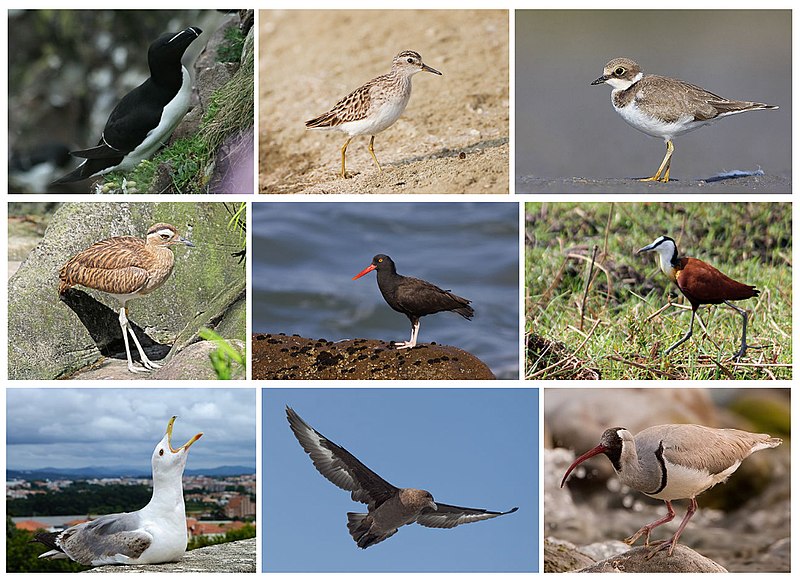
Shorebirds, a diverse group of birds in the Charadriiformes order, are found near water on every continent except Antarctica.
These small to medium-sized birds feed mainly on invertebrates and other small animals but can also be pelagic seabirds or inhabit deserts.
Shorebirds use their long bills to probe mudflats for food like worms and mollusks while some species plunge into the ocean’s depths in search of crustaceans such as crabs and shrimp.
They have strong legs equipped with webbed feet which allow them to move quickly when searching for prey across wetlands, sandbars, beaches and swamps.
Their feathers make them well adapted to life by land or sea due to its hydrophobic nature which helps reduce drag during swimming or flying through windy conditions making it easier for shorebirds survive tough environments around the world.Scientific classification:
| Kingdom | Animalia |
| Phylum | Chordata |
| Class | Aves |
| Infraclass | Neognathae |
| Clade | Neoaves |
| Clade | Gruimorphae |
| Order | Charadriiformes Huxley, 1867 |
46. Ring-Billed Gull
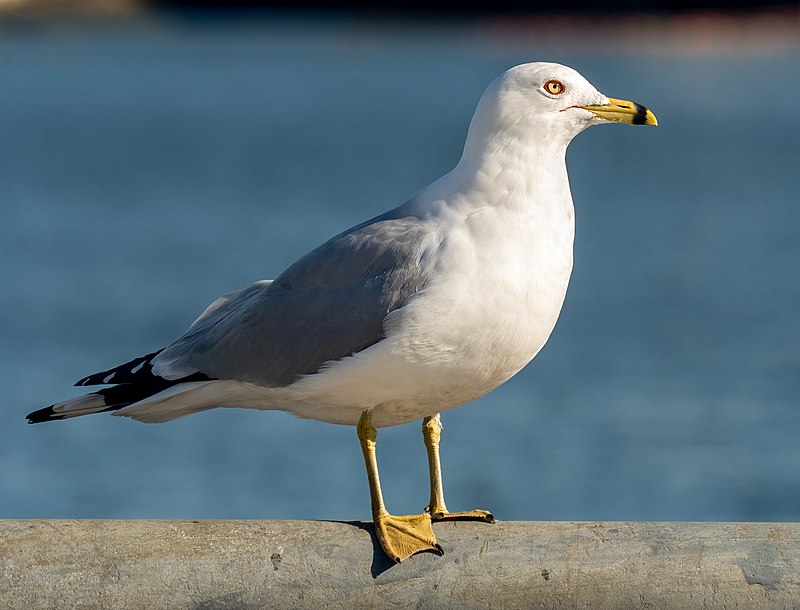
The Ring-billed Gull is a medium sized seabird that can be seen throughout North America. Its head, neck and underparts are white while its back and wings are silver gray in color.
It has a relatively short yellow bill with a dark ring around it, as well as yellow legs.
The genus name for this species of gull comes from the Latin word ‘Larus’ which referred to large sea birds or gulls; while the specific delawarensis refers to the Delaware River where these birds were first discovered.
These beautiful creatures thrive near coasts, lakeshores and other bodies of water but also have been known to inhabit urban areas such as parks close by those watersides due to their adaptability towards human habitats.Scientific classification:
| Kingdom | Animalia |
| Phylum | Chordata |
| Class | Aves |
| Order | Charadriiformes |
| Family | Laridae |
| Genus | Larus |
| Species | L. delawarensis |
47. Pygmy Nuthatch
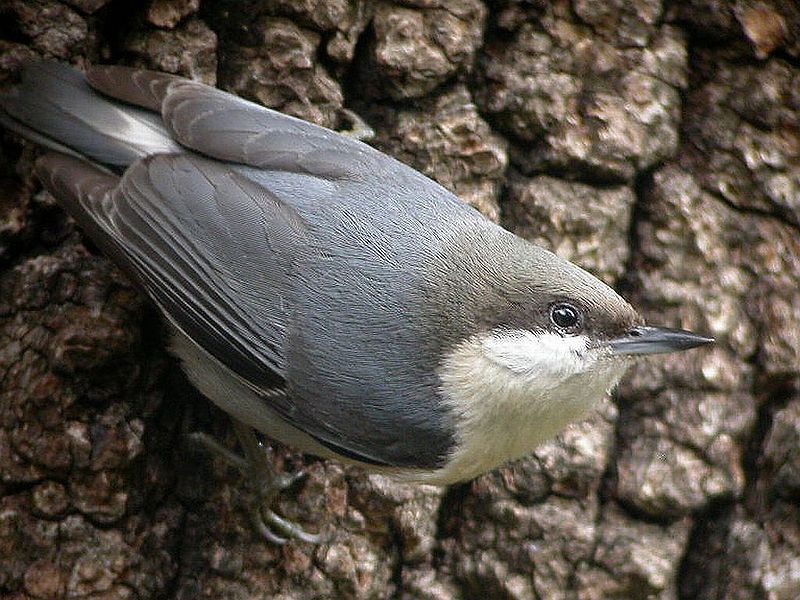
The Pygmy Nuthatch is a small songbird, measuring only 10 cm (4 in) long and weighing around 10 grams.
It can be found across the western U.S., from southern British Columbia to central Mexico, although its presence has become quite fragmented due to habitat loss.
This species primarily inhabits coniferous forests of pines, Douglas-firs and other evergreen trees – usually ponderosa pines.
The Pygmy Nuthatch is particularly adept at foraging among pine cones; it uses its strong bill to remove seeds while perched upside down on them.
Its plumage includes shades of greyish blue with white underparts and a brown cap that is often raised when excited or alarmed during flight displays.Scientific classification:
| Kingdom | Animalia |
| Phylum | Chordata |
| Class | Aves |
| Order | Passeriformes |
| Family | Sittidae |
| Genus | Sitta |
| Species | S. pygmaea |
48. Red-Breasted Sapsucker
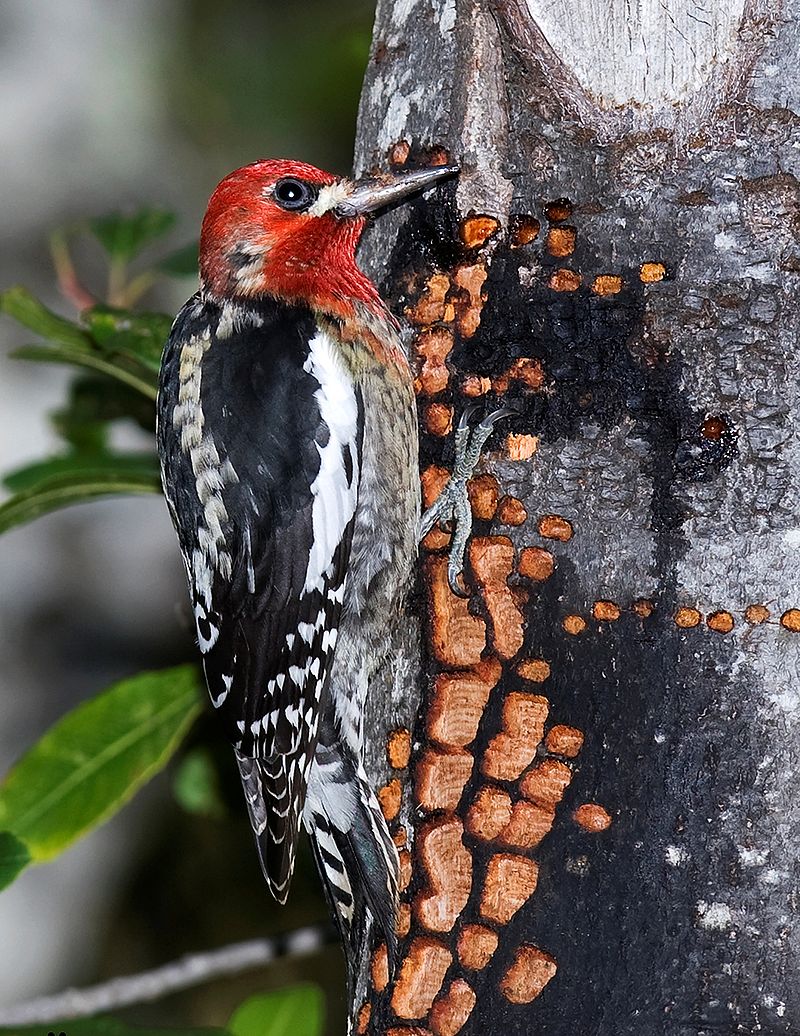
The red-breasted sapsucker is a medium-sized woodpecker native to the forests of the west coast of North America.
It has a striking appearance with its bright red head and upper chest, white lower belly, black back and wings with bars and large white wing patch.
These birds nest in tree cavities during mating season while northern specimens migrate south for winter months.
They are often seen tapping on trees to drill holes into them in order to feed on sap or bark insects that live beneath it.
Additionally, they have been observed feeding from birdfeeders which makes them great additions to backyard bird watching activities.
Overall, the red-breasted sapsucker is an interesting species worth discovering.Scientific classification:
| Kingdom | Animalia |
| Phylum | Chordata |
| Class | Aves |
| Order | Piciformes |
| Family | Picidae |
| Genus | Sphyrapicus |
| Species | S. ruber |
49. Wilson’s Warbler
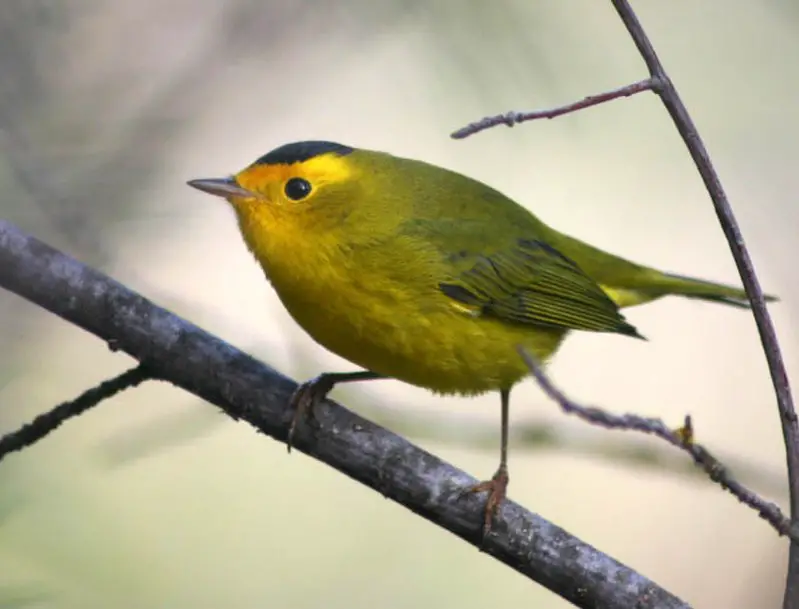
Wilson’s warbler is a small, brightly coloured bird found across North America. It has greenish upperparts and yellow underparts, with rounded wings and a long tail.
The male has an easily identifiable black crown patch which may or may not be present in the female depending on the subspecies.
They breed from Canada down to central parts of Mexico and then winter south through much of Central America.
These birds are usually seen flitting around low vegetation as they search for insects to eat – their main food source.
Their cheerful song can often be heard during spring migration when they travel back up north to breed again after spending winter further south.Scientific classification:
| Kingdom | Animalia |
| Phylum | Chordata |
| Class | Aves |
| Order | Passeriformes |
| Family | Parulidae |
| Genus | Cardellina |
| Species | C. pusilla |